Benvenuti a Polignano
Think of Puglia and you may well picture Polignano a Mare. A town where whitewashed houses cling to limestone cliffs above a sparkling Adriatic, it offers one of the region’s most iconic views — often gracing the covers of guidebooks. Its popularity and status come at a price: Polignano is among the more expensive destinations to stay in by Puglian standards. But it is also one of the most accessible, with frequent trains running along the Adriatic line between Bari, Brindisi and Lecce.
The Puglia Podcast is also available from Apple Podcasts, Spotify and wherever else you get your podcasts from.
The basics
The small but perfectly formed centro storico is reached through the Porta Vecchia gate. Within, narrow whitewashed streets wind towards sudden terraces over the sea. Exploring becomes an adventure, particularly if you follow the words of poetry painted across walls, doors, and stairways.
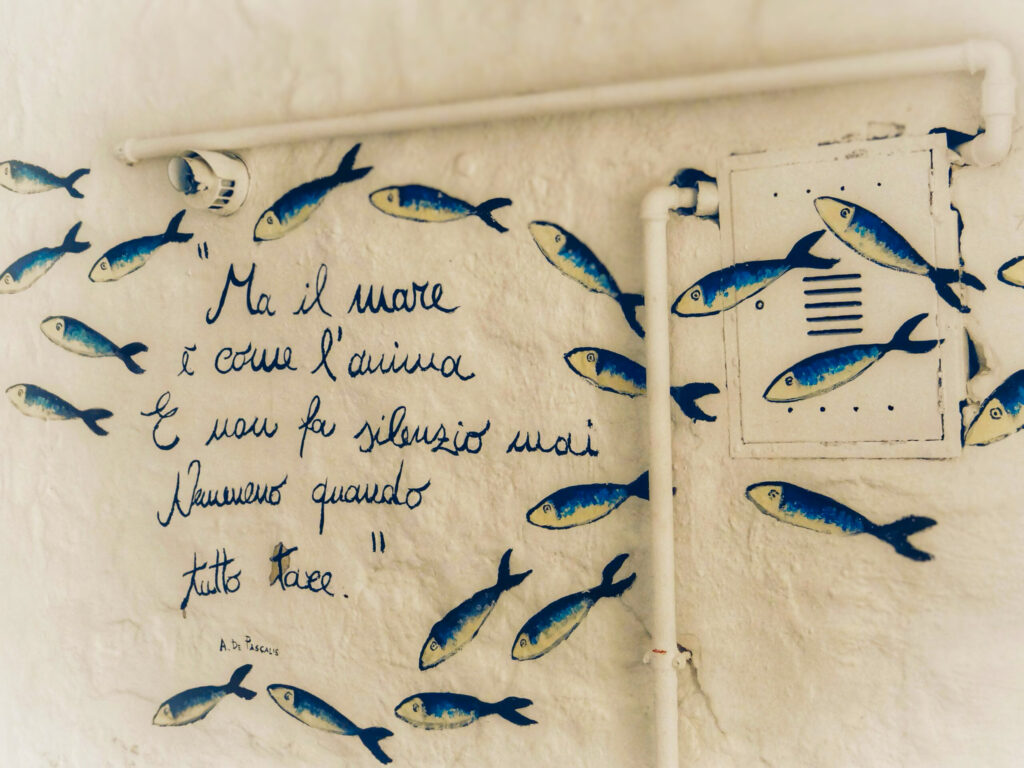
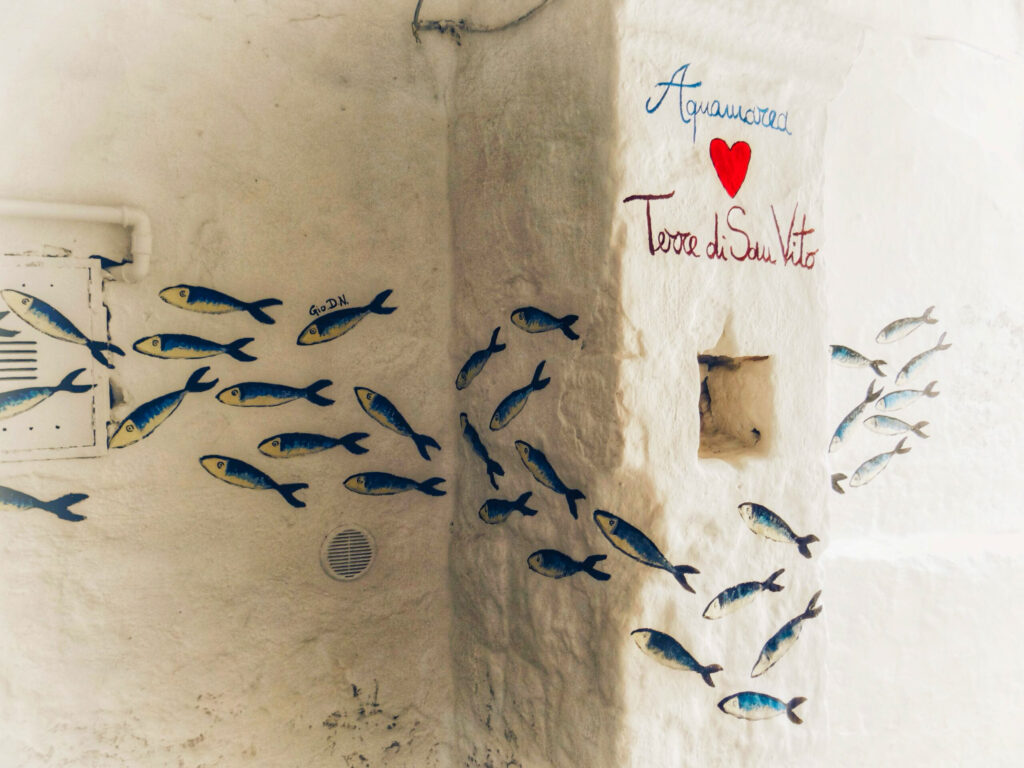
This tradition was started in 1992 by Guido Lupore — signing his work as Guido il Flâneur. His first piece, in Piazza Santo Stefano, was dedicated to dolphins. Since then, his verses, and those he borrows from other poets, have multiplied across the town. The most famous example is the Vicolo della Poesia — the “poetry steps” tucked away in the historic centre.
With superb seafood (the town’s name a Mare says it all), cool bars like La Casa del Mojito on Via Annunziata, chic boutiques, and — above all — that view, Polignano a Mare has much to offer.
A history carved in rock
Legend has it Polignano was formed when a piece of the Greek coast broke away and drifted across the Adriatic. What we do know is that people have lived here since prehistory. Artefacts from caves such as Grotta dei Colombi, Grotta del Guardiano and Grotta dei Ladroni reveal Palaeolithic and Neolithic habitation.
The town likely emerged in the 4th century BC, founded by Dionysius II of Syracuse for its strategic coastal position. During the Roman era Polignano became a stop on the Via Traiana — the road connecting Benevento with Brindisi. The Roman bridge above Lama Monachile still survives, part of the extension of the Appian Way built in 109 AD.
Over the centuries Polignano fell under Byzantine, Norman, Angevin, Aragonese, and Bourbon control. By the 11th century it was a Norman county; later a marquisate under the Kingdom of Naples. The town’s medieval walls and fortified character date from these eras.
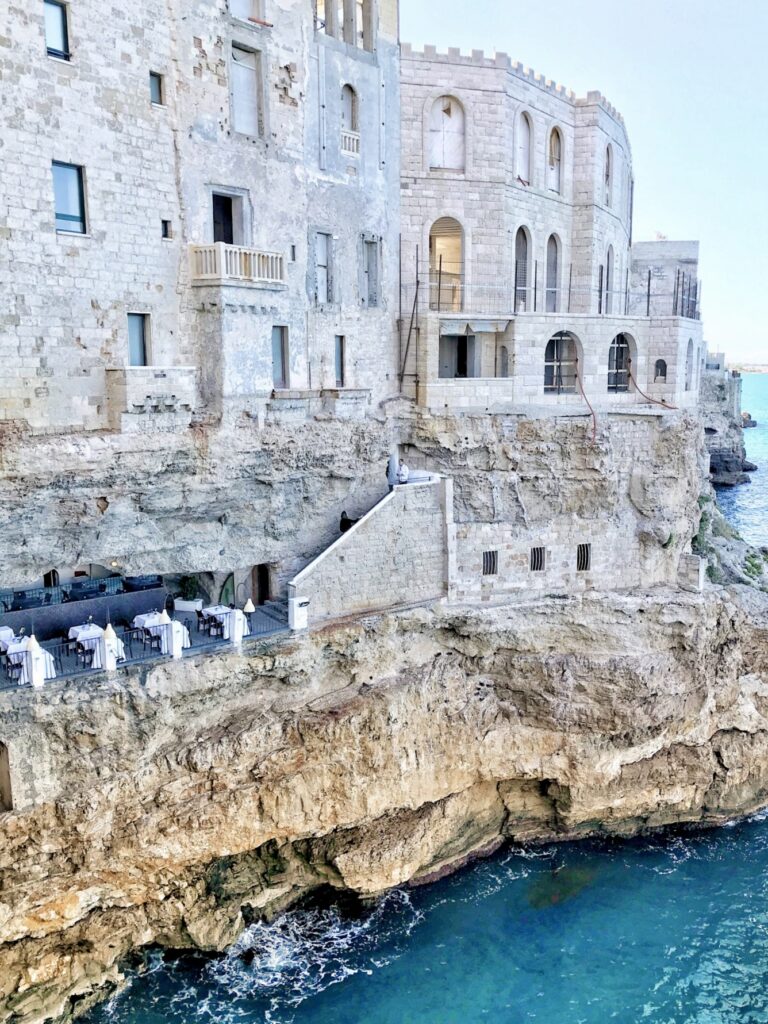
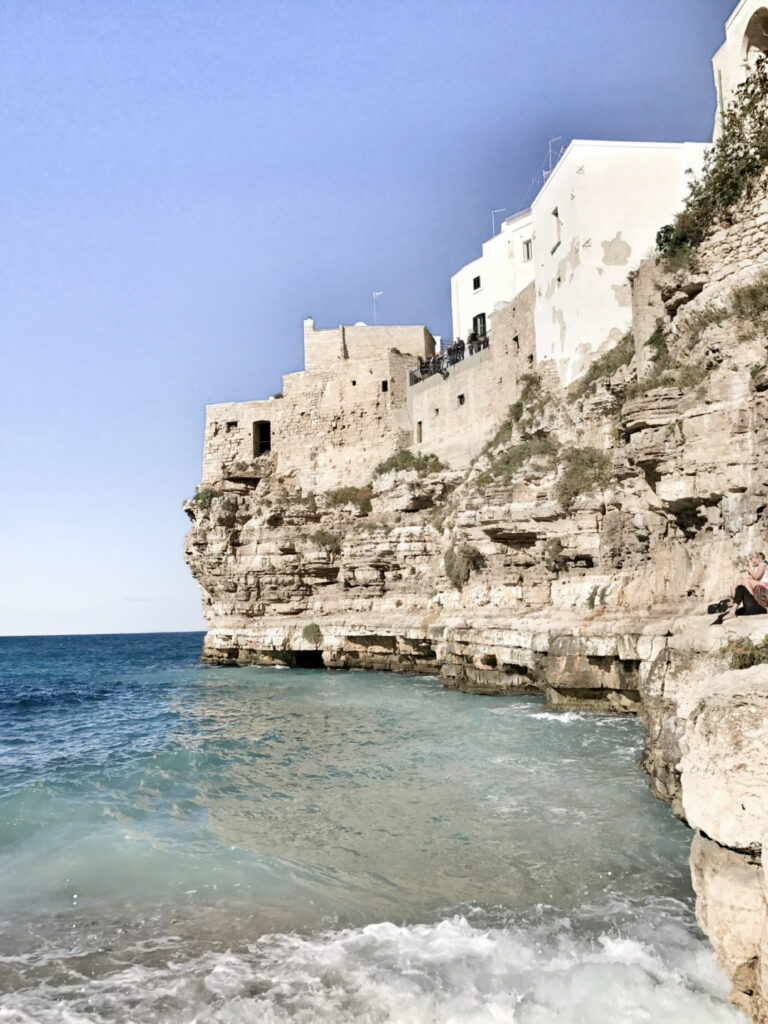
Centro storico
The centro storico is a maze of winding alleys, whitewashed houses and tiny balconies suspended above the sea. Remnants of the medieval walls enclose the quarter, once protected by four towers. Entry is through the Porta Grande (or “Arco Marchesale”), which leads directly to Piazza Vittorio Emanuele II.
Here you’ll find a 19th-century public clock — one of the few still wound manually by ropes — and the 16th-century Parish House, supported by seven arches. The Chiesa Matrice (Mother Church), built in 1295, blends Renaissance and Baroque design and houses treasures including:
- A 16th-century inlaid wooden pulpit
- A 1776 baptismal font with a polychrome marble pyramid
- A carved wooden choir from 1661
- A polyptych by Venetian painter Bartolomeo Vivarini
- A nativity scene sculpted from carparo tuff by Stefano da Putignano
Nearby religious landmarks include the Chiesa del Purgatorio with its ornate Baroque façade, and the former Church of San Stefano, now an art gallery.
Expansion and economy
Beyond the medieval walls, Polignano began to expand in 1786 under King Ferdinand IV of Bourbon. The modern town stretches inland and along the coast road towards Monopoli and Mola di Bari.
Today, Polignano’s economy thrives on tourism, fishing, agriculture and trade. Its restaurants serve the freshest seafood alongside Puglian staples like orecchiette pasta, burrata, focaccia barese and — of course — spaghetti all’assassina Polignano style (with octopus).
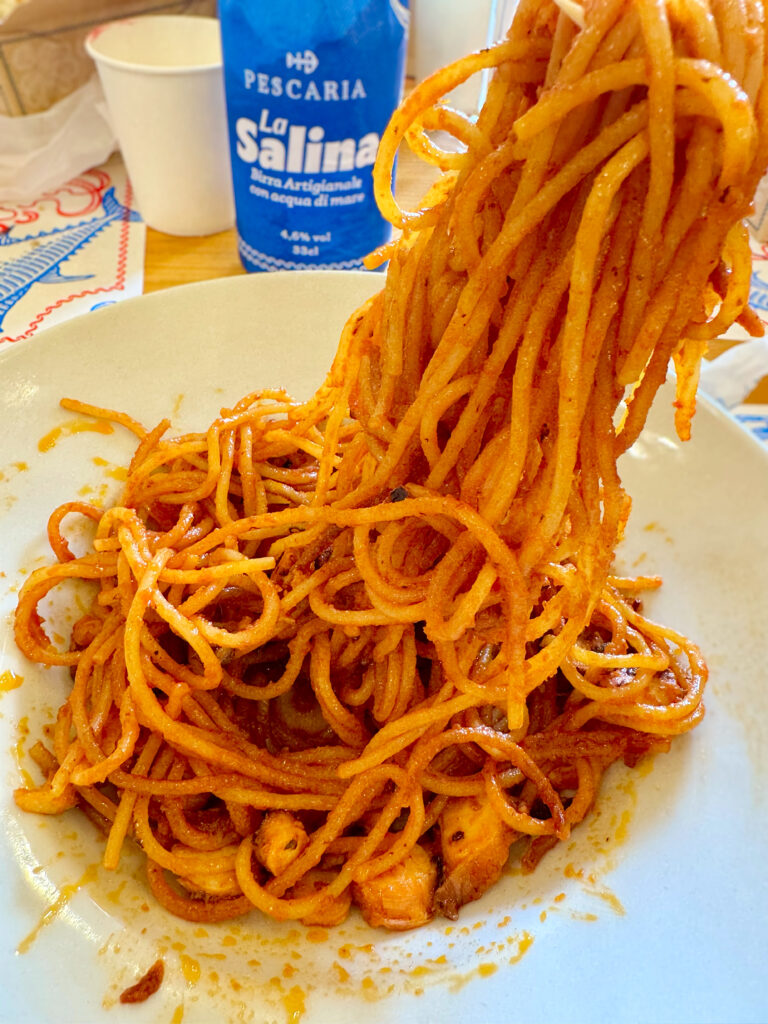
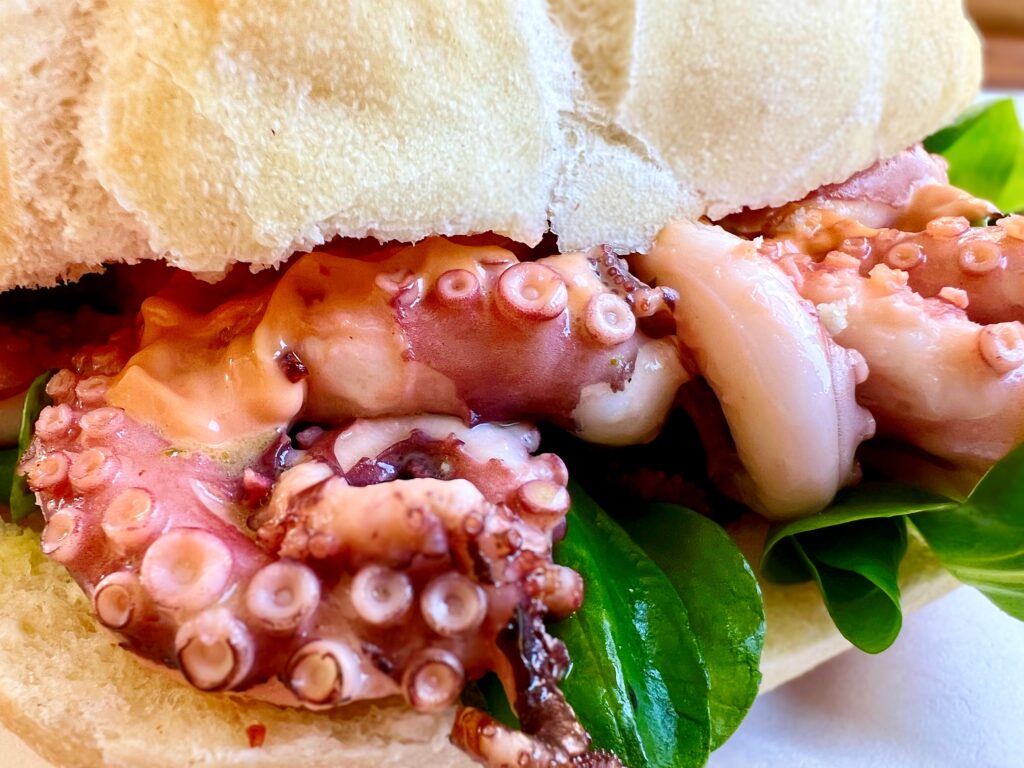
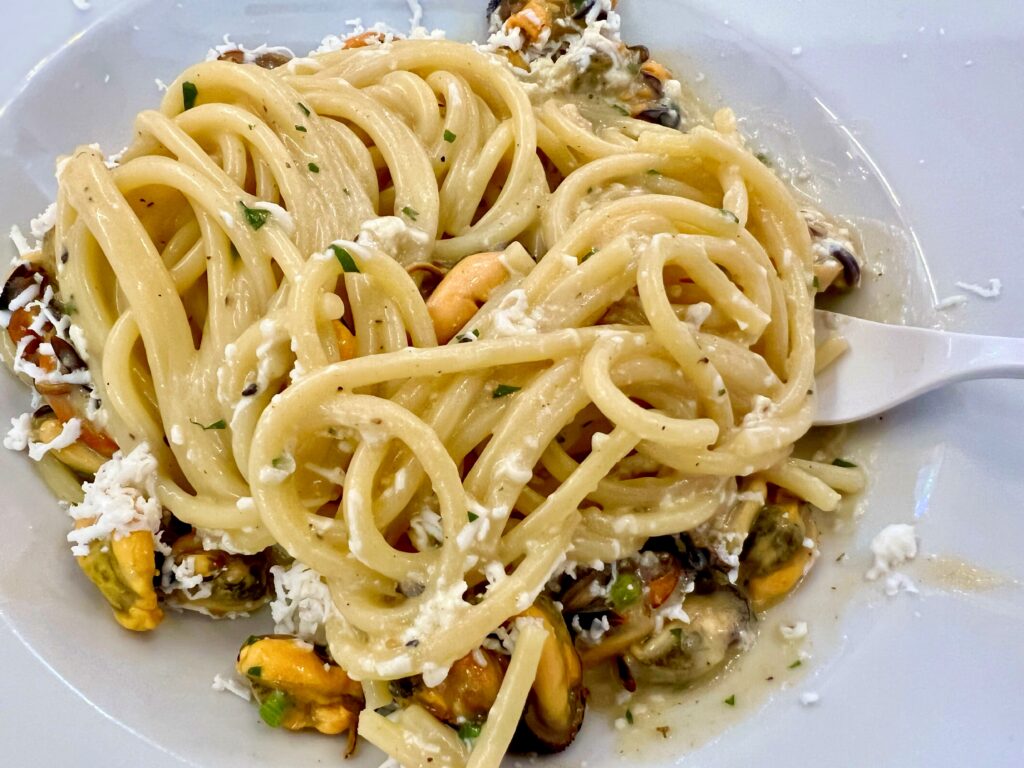
Beyond the old town
Polignano’s coastline is riddled with erosion-carved caves, the most famous being Grotta Palazzese. Many others — Grotta di Ardito, Grotta delle Rondini, Grotta dei Colombi, Grotta delle Monache — are only accessible by boat, making a cave tour one of the town’s unmissable experiences.
Three kilometres north, the Abbey of San Vito stands on a narrow peninsula, believed to be the site of the ancient Roman settlement of Apenestae. Once home to Benedictine monks, the abbey retains its Romanesque architecture with a three-domed nave and a crumbling watchtower looking out to sea.
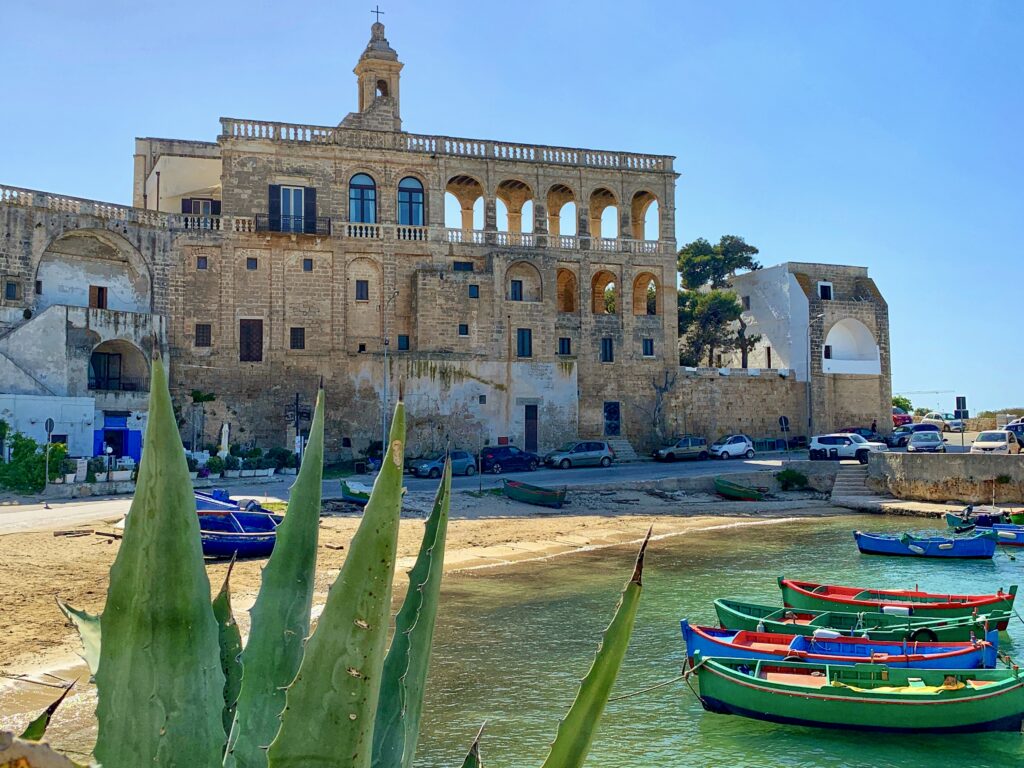
In the blue painted blue
The beauty of Polignano has long inspired artists, poets, and musicians. Most famously, it is the birthplace of Domenico Modugno, singer of Nel blu, dipinto di blu (Volare), the world’s most-played Italian song. His statue, arms outstretched in his famous pose, stands proudly above the seafront steps that bear his name.
In the blue painted blue. That’s Polignano a Mare!

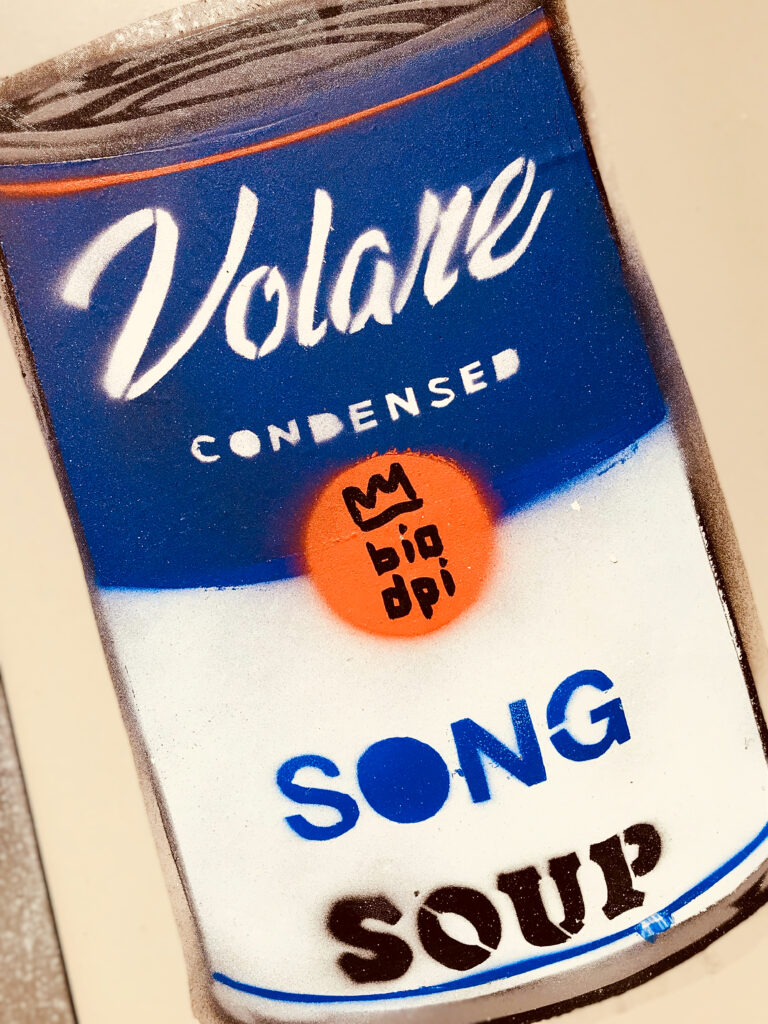
Getting there
Polignano sits on the main Adriatic railway line and is easily reached by train in around 30 minutes from Bari, and under 10 minutes from Monopoli (though not all Monopoli – Bari trains stop there). Services are frequent and reliable. By car, take the SS16 coast road.
Parking
Driving into Polignano can be stressful in high season, with limited spaces near the old town. We usually aim for Piazza Aldo Moro, the main square, and look for spaces in the surrounding streets. If those are full, head to the train station area — parking there is usually easier, and it’s less than a 10-minute walk back to Piazza Aldo Moro and about 300 metres further to Lama Monachile.
Another option is to turn off towards the sea and try around Piazza Trinità, though spaces here can also be competitive in peak summer.
What to see
Centro storico
Polignano’s old town is compact but atmospheric, entered through Porta Grande. Whitewashed houses, narrow lanes, and hidden terraces open suddenly onto unforgettable sea views. Look out for the verses of poetry painted on walls and doorways, a tradition started by Guido il Flâneur and continued by others.
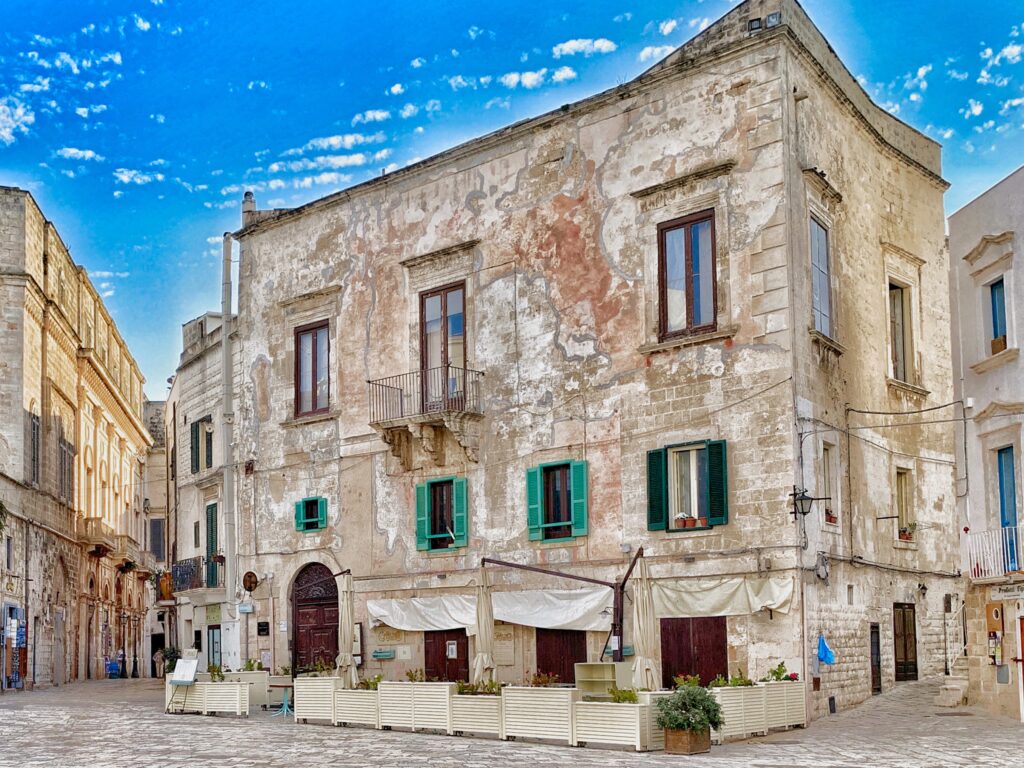
Lama Monachile
Polignano’s most iconic beach lies just beneath the old Roman bridge. This small pebble cove, framed by cliffs and lapped by crystal-clear water, is one of the most photographed spots in Puglia. Historically used as a port, today it is a magnet for swimmers and sunbathers.
It’s rocky underfoot and rapidly deep, with limited space — particularly crowded at the height of summer. Brave locals and teenagers leap off the cliffs all day long. But take care: in August 2025, a 23-year-old Italian tourist died after diving from several metres up.
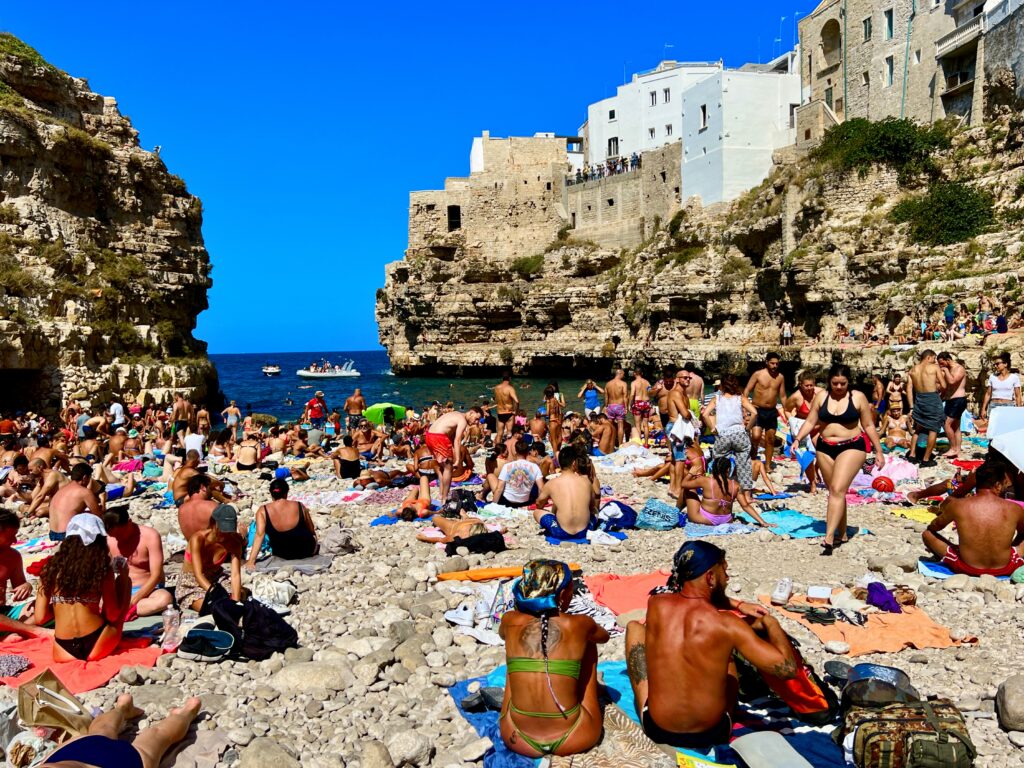
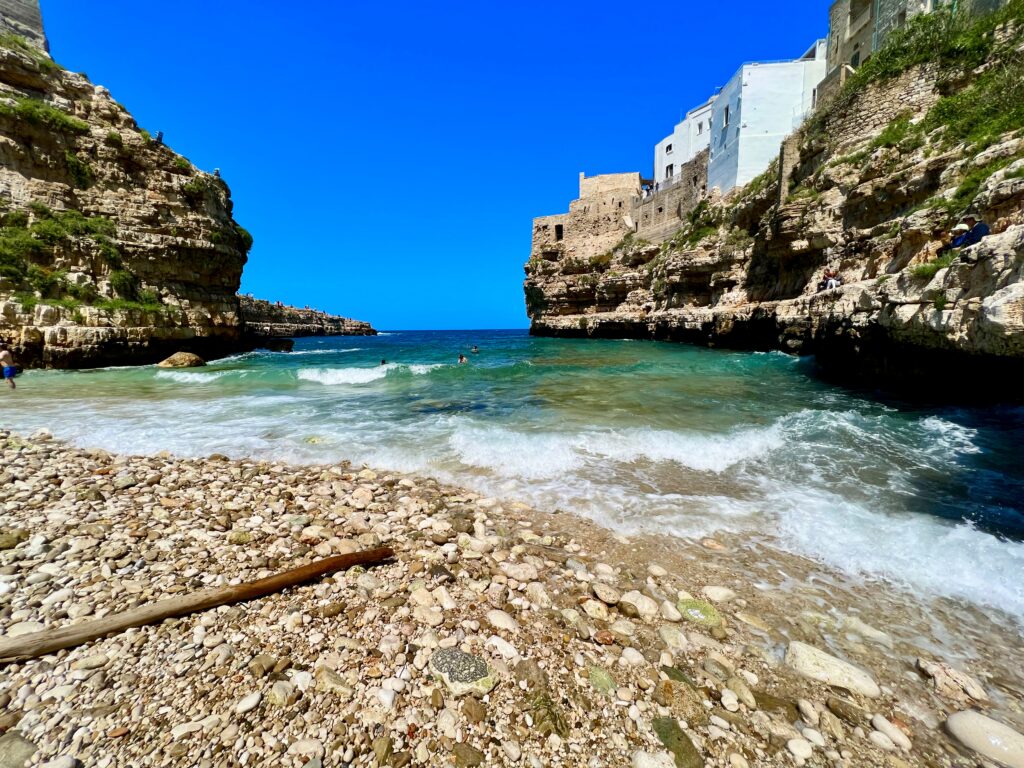
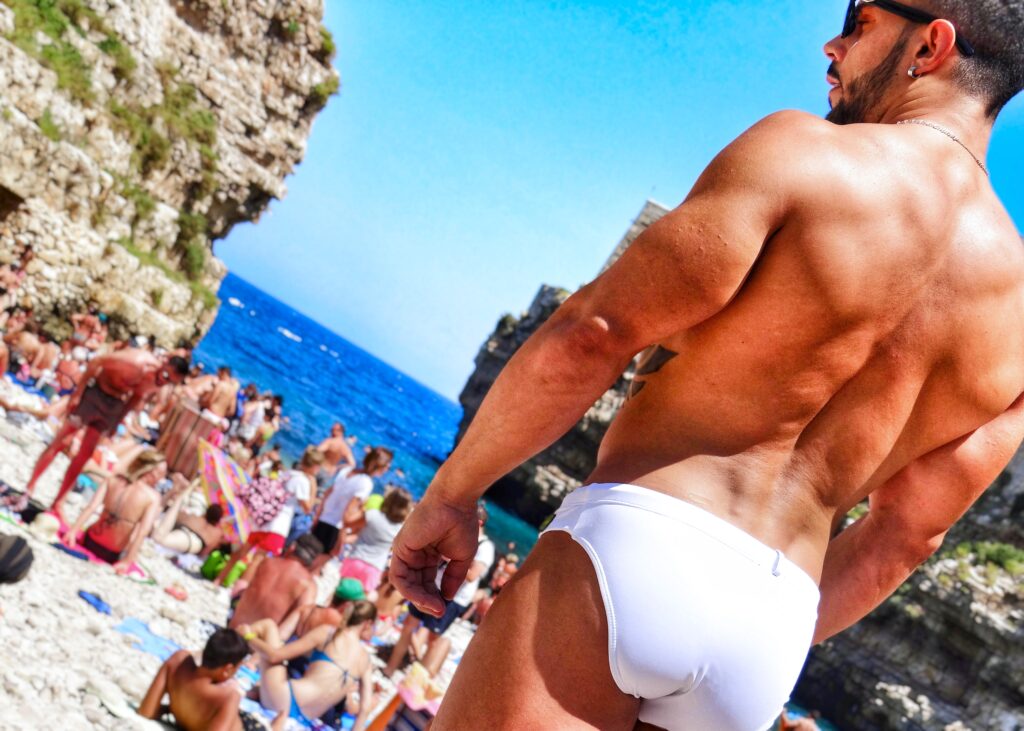
Red Bull Cliff Diving World Series
Each summer Polignano a Mare takes centre stage in the Red Bull Cliff Diving World Series, one of the most spectacular sporting events on the planet. Since 2009, the town has been a regular stop on the tour, attracting elite divers from around the globe who hurl themselves into the Adriatic from heights of up to 27 metres.
What makes Polignano unique is the setting: athletes dive from private balconies and platforms built into the clifftop, right above Lama Monachile beach. Thousands of spectators pack the old Roman bridge, the surrounding terraces, and the beach below to watch. Boats crowd the cove and kayaks line up just offshore for a sea-level view. The atmosphere is electric, with the town buzzing for days before and after the competition.
For Polignano, the event has become as much a showcase as a sporting contest, cementing its reputation around the world. While dates vary each year, the event usually takes place in July or early September. Admission is free, but space is limited — arrive early if you want a good spot, and expect crowds.
Insider tip: The best views are often from the sea. If you’re in town during the event, consider booking a boat tour in advance — you’ll have a front-row seat as divers plunge into the turquoise waters right beside you.
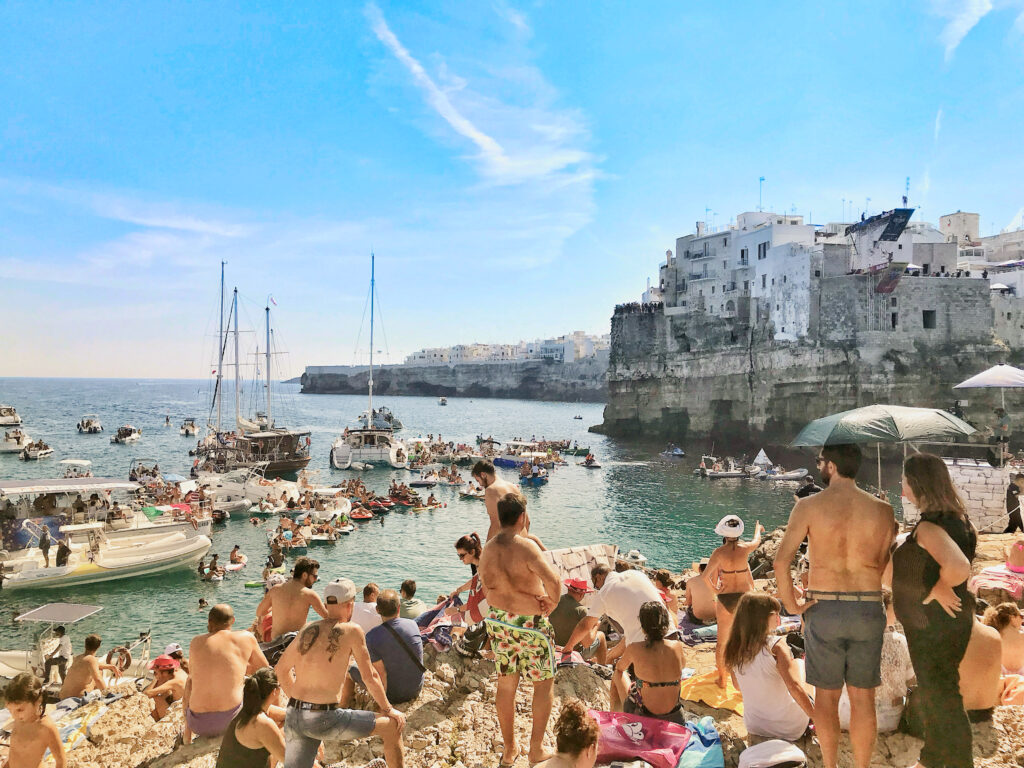

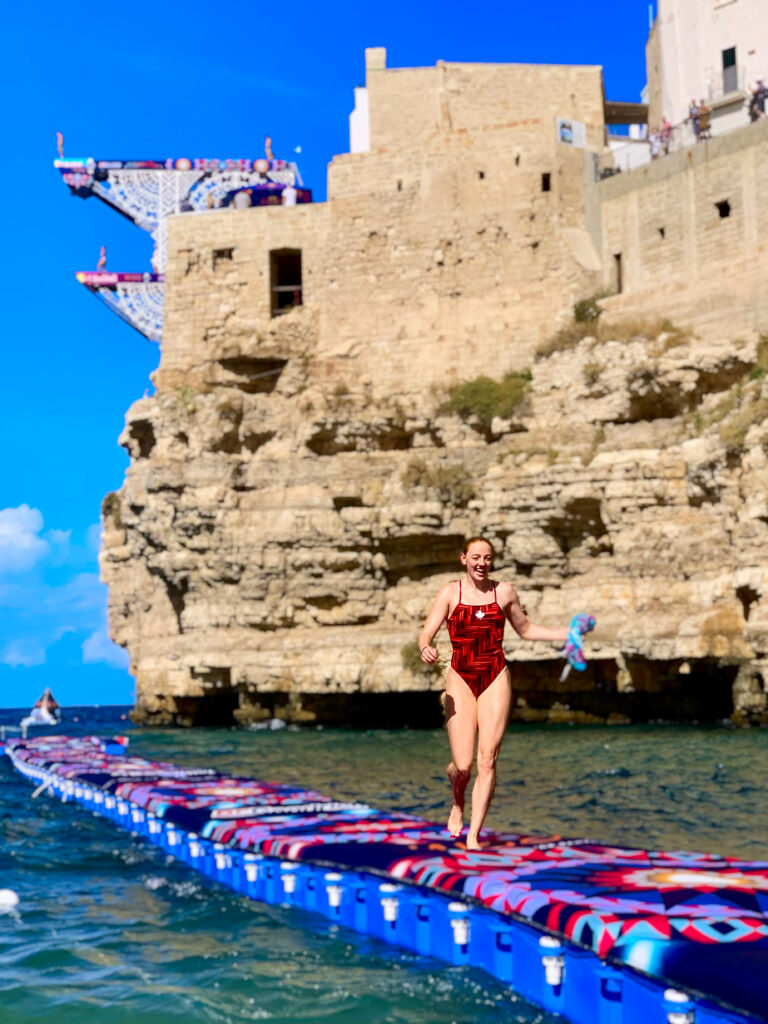
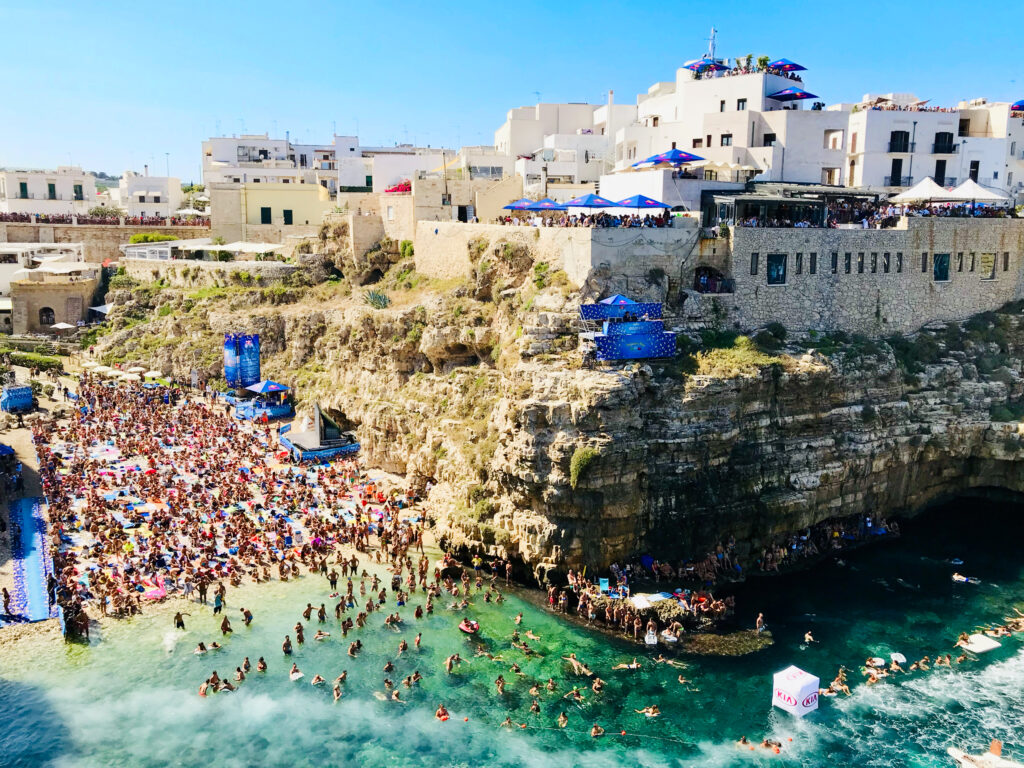
Balconies and terrazze
Polignano is made for panoramas. Don’t miss Terrazza Santo Stefano, Via Roma’s viewpoints, and the terraces within the centro storico — each offering a different angle of the cliffs, caves, and sea.
Domenico Modugno statue and steps
Find the statue of Domenico Modugno (“Monumento a Domenico Modugno”), Polignano’s most famous son. The Italian singer co-wrote and originally performed Nel blu, dipinto di blu — universally known as Volare. It remains the most-played Italian song in the world, and arguably the most famous song never to have won the Eurovision Song Contest.
The song came third in the 1958 Eurovision Song Contest. In 2005 it was voted the second “all-time favourite Eurovision song,” behind ABBA’s Waterloo. Benny Andersson of ABBA himself said he had voted for it.
Modugno was born here in 1928, and locals remain deeply proud of their celebrated citizen. The bronze statue shows him frozen mid-performance in his famous Volare pose — arms outstretched, face lifted to the sky. It stands above the Modugno steps, which lead down to Spiaggia Domenico Modugno, one of the best viewpoints of the old town from below. The lyrics to the song light up Via Roma, part of Polignano’s illuminations.
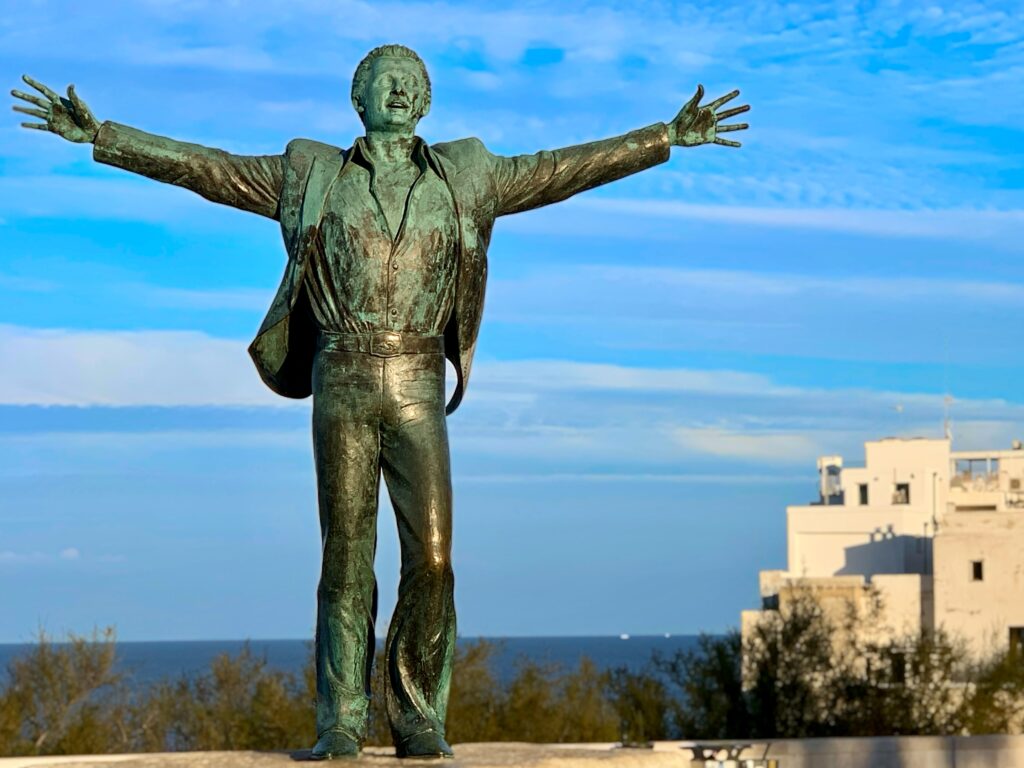
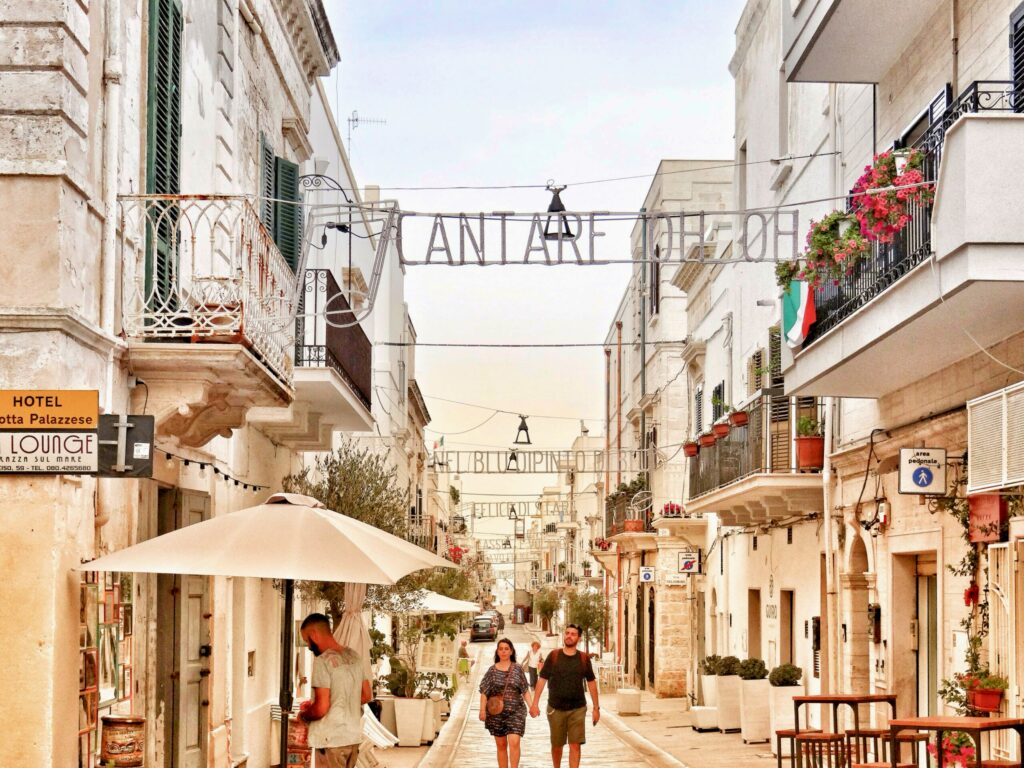
A warning to the curious | Grotta Palazzese
Set dramatically into the cliff with terraces overlooking the Adriatic, Grotta Palazzese is one of the most photographed restaurants in the world. The setting is extraordinary — but it’s the location, not the food, that diners pay for.
In 2019, under previous management, the restaurant was fined the maximum penalty for cooking with out-of-date meat (a month past its date). Authorities also found undocumented seafood and frozen cuts of meat without traceability.
Members of the team have eaten here twice. In 2020 and again in 2024. On both occasions the food was extremely disappointing and ultra expensive by local standards. We regularly eat far better elsewhere in Polignano for a fraction of the cost. We hesitate to call anywhere a “tourist trap,” but in this case nothing else seems appropriate.
Our advice? Do your due diligence and read reviews before booking. Many diners report the same experience of “overpriced bill, disappointing food.” If you do choose to go, reserve well in advance and brace yourself for a menu whose prices are as breathtaking as its views. Guests arriving by car can park on the outskirts of town, from where the restaurant arranges private transport.
Update: In March 2025 Grotta Palazzese is set to reopen under chef Martino Ruggieri, originally from Martina Franca and recently returned from Paris where he earned two Michelin stars in under two years with Maison Ruggieri. The Polignano cave restaurant will be one of four venues he manages under the Grotta Palazzese brand. We can only hope the new era brings genuine culinary substance to match the spectacular setting.
Friends visiting in June 2025 dined here. They confirmed that it was beautiful, the prices eye-watering (a beer for €35), but that it still was style over substance. The food was far from the best they had on their visit to Puglia.
Insider tip: For an authentic experience that locals can afford, head to Cala Paura, where kiosks serve freshly grilled octopus panini at tables overlooking the sea. For fine dining, head to Da Tuccino instead.
Boat tours and sea caves
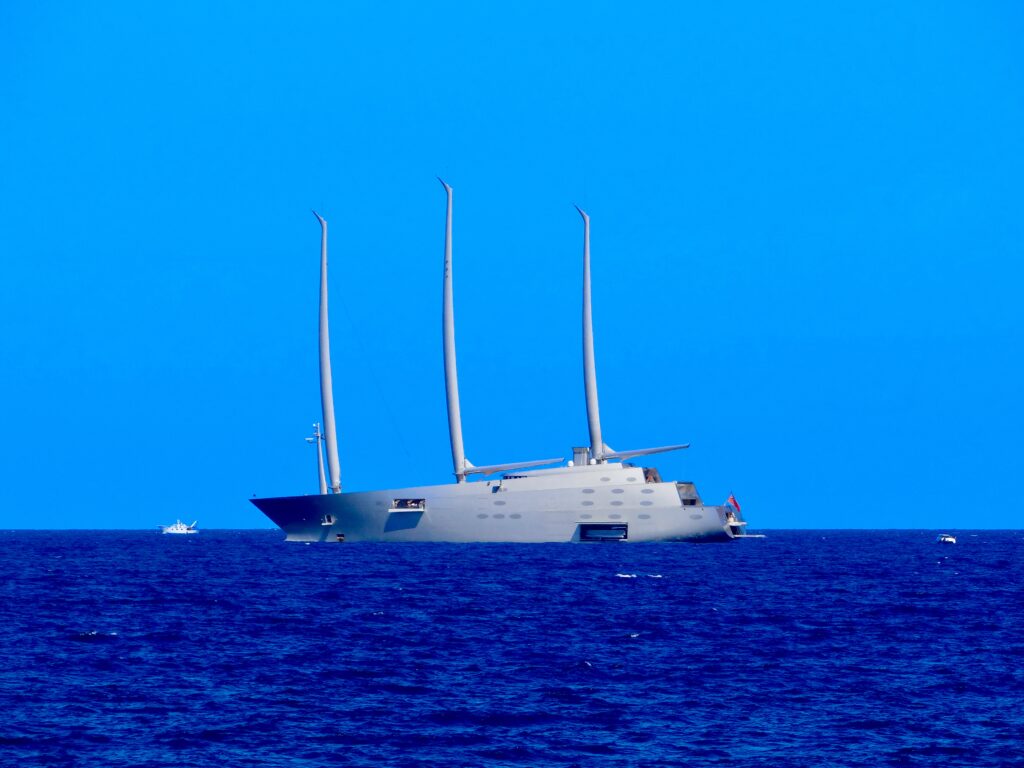
Polignano is carved out of cliffs riddled with caves, grottoes, and hidden coves. The best way to experience them is from the water. Small boats, dinghies, and kayaks depart from the harbour at Cala Paura or San Vito, taking you beneath the old town and into spectacular sea caves including the Grotta dell’Amore and Grotta Palazzese.
Tours usually last 1–2 hours, with options to swim in secluded inlets. Prices are competitive, especially if you share a small group boat. Kayak and SUP rentals are also available for those who prefer to explore at their own pace.
Insider tip: Early morning or late afternoon trips are quieter, with the best light for photography. In peak summer, book in advance as tours fill quickly.
What to Do
Polignano may be small, but there’s plenty to fill your days here — from art and architecture to seaside strolls, contemporary design, and one-of-a-kind local flavours.
Caffè Speciale and Gelato
Polignano is also known as la città del gelato — the town of ice cream. Don’t miss the caffè speciale, invented by Mario Campanella at Il Super Mago del Gelo: a unique blend of espresso, sugar, cream, lemon zest and Amaretto liqueur. Pair it with a cone of artisanal gelato for the quintessential Polignano experience.
Lama Monachile and the Roman Bridge
The most iconic view of Polignano. The pebble beach of Lama Monachile is framed by soaring cliffs and overlooked by a Roman bridge, once part of the Via Traiana. Access is via the stone steps behind the bridge or a ramp from Via Conversano. There are no facilities on the beach, but it’s right in the town centre.
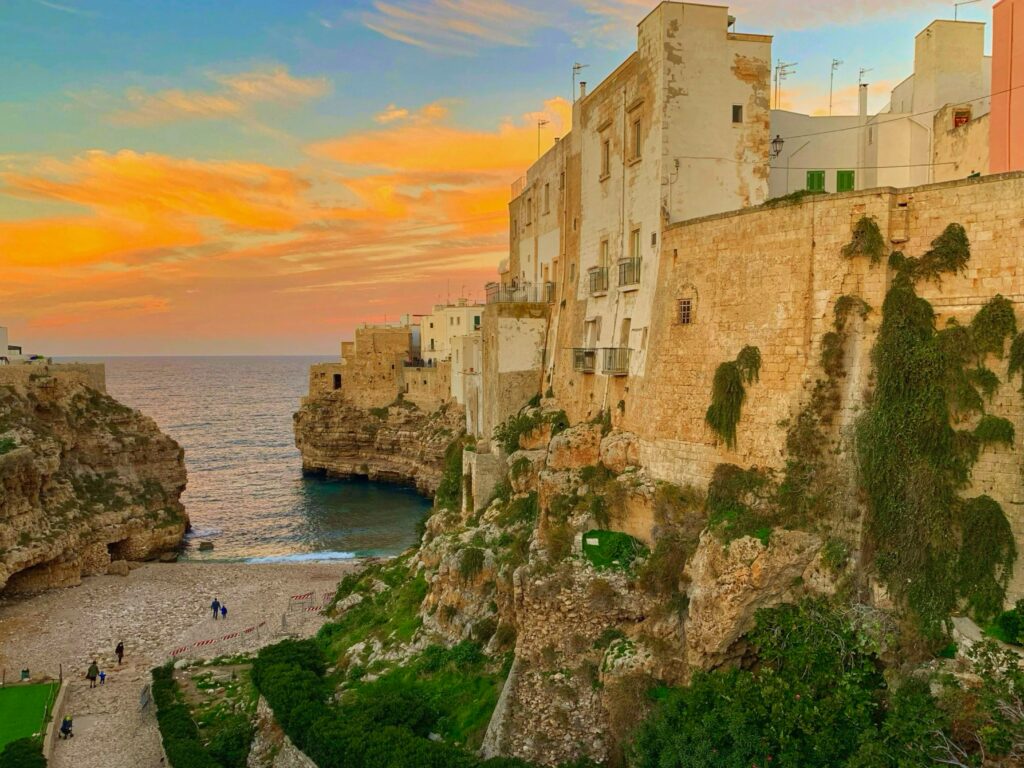
Museum of Contemporary Art – Pino Pascali
Via Parco del Lauro, 119 | +39 080 4249534 | Museo Pino Pascali
Puglia’s only permanent contemporary art museum, named after Polignano-born artist and sculptor Pino Pascali. Alongside a permanent collection of his works, the museum hosts rotating temporary exhibitions of modern art.
Seafront Promenade
Promenades stretch both north and south of the centro storico, offering superb views of cliffs and caves. The most dramatic panoramas are from the southern balcone, the Roman bridge, and Spiaggia Domenico Modugno. From the singer’s statue, steps lead down to the seafront.
Peppino Campanella – Oggetti di Luce
Via Conversano, 9 | +39 335 672 6257 | peppinocampanella.it
A dazzling workshop-gallery tucked into a side street, where designer Peppino Campanella creates unique glass and light sculptures. Each piece blends colour, light and form in ways that capture the Adriatic’s luminous quality.
Santa Maria Assunta
Polignano’s Mother Church, originally built in 1295, blends Renaissance and Baroque design. Inside are artistic treasures, including a stone nativity scene attributed to Stefano da Putignano, one of the region’s leading sculptors in the 17th and 18th centuries.
Abbazia di San Vito
Three kilometres northeast of Polignano, the Benedictine abbey of San Vito occupies a narrow peninsula jutting into the sea. Its Romanesque architecture includes a three-domed nave and crumbling watchtower, with a small fishing harbour at its feet. The annual Festa di San Vito in June begins here with a procession by boat.
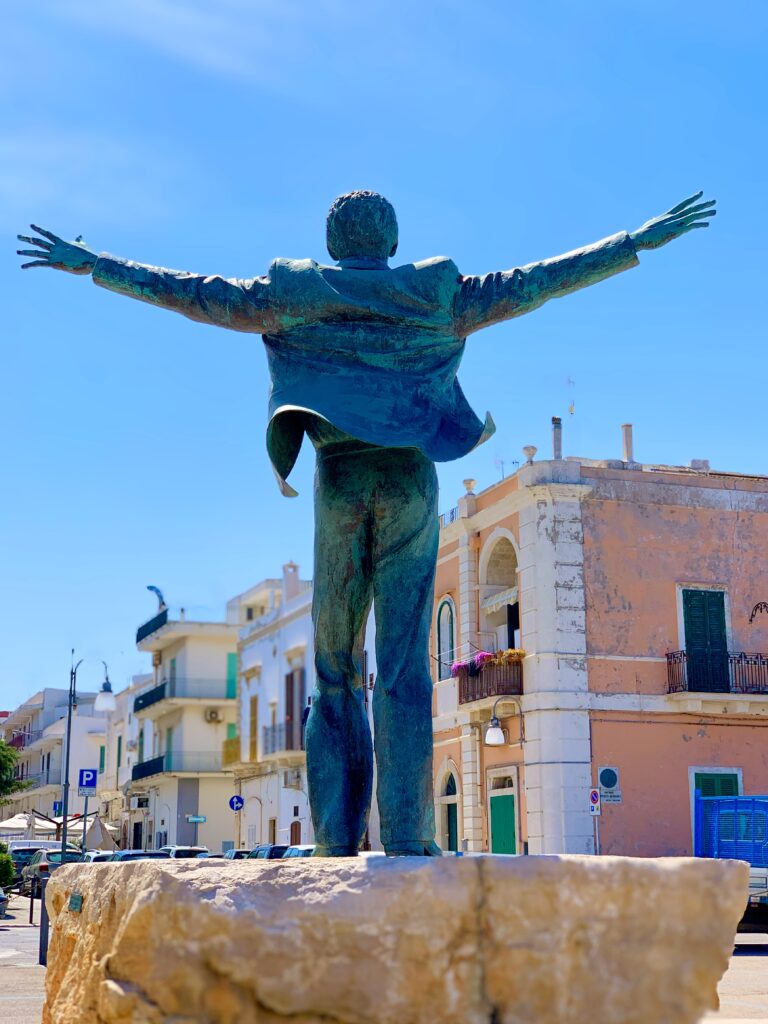
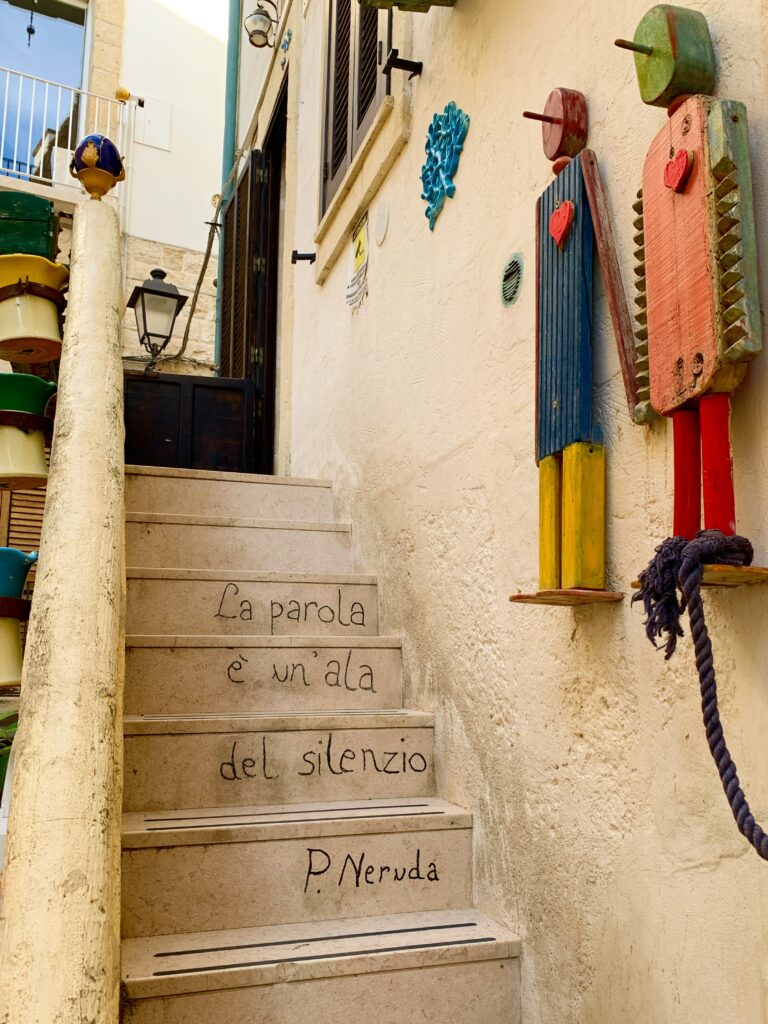
Where to eat
Our biggest challenge in Polignano a Mare? There’s never enough time in the day to fit in all the food we want to eat. Seafood is a speciality, but after its beach and Domenico Modugno, Polignano is also famed for its outstanding gelato.
Pescaria
Piazza Aldo Moro, 6/8 | pescaria.it | €–€€
The street-food spot that put Polignano on Italy’s foodie map. Expect queues for its epic raw, fried, and cooked seafood panini — from fried octopus with cime di rapa, garlic, ricotta, fig syrup and anchovy oil, to red shrimp tartare with buffalo mozzarella, passion fruit mayo, and Polignano carrot chips.
Insider tip: To avoid the long queues at Pescaria, go outside peak mealtimes — late morning or mid-afternoon — when you’ll often walk straight in. For a bite by the seaside, skip the crowds altogether and head to Cala Paura, where kiosks serve freshly grilled octopus panini at tables overlooking the sea.
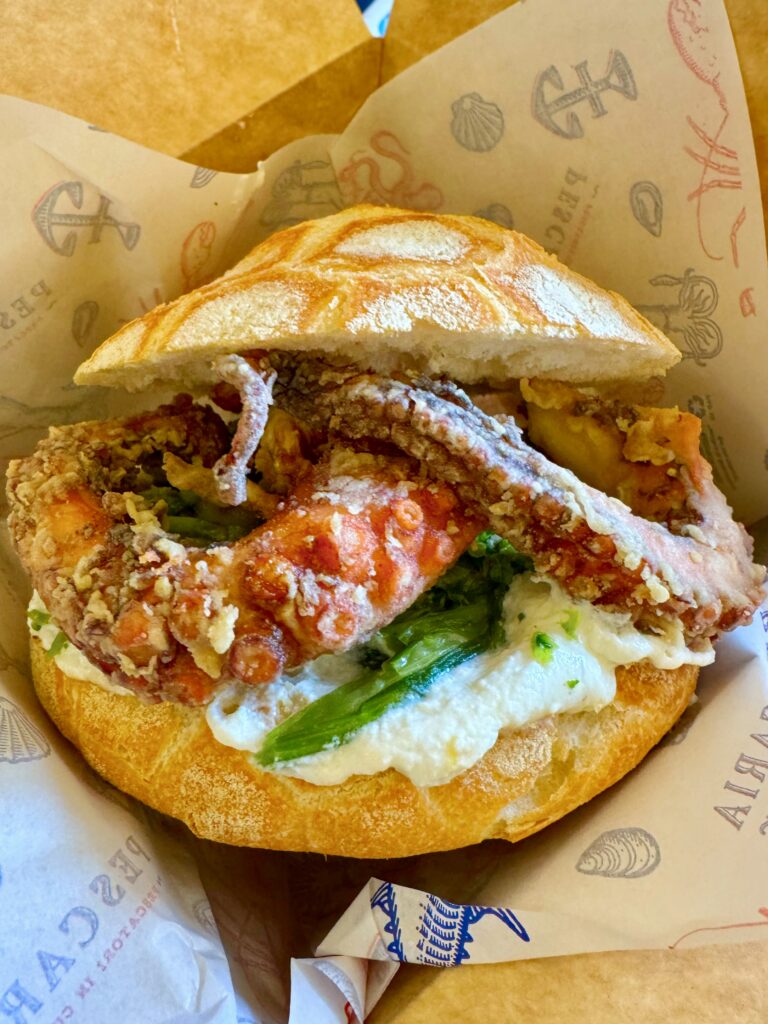
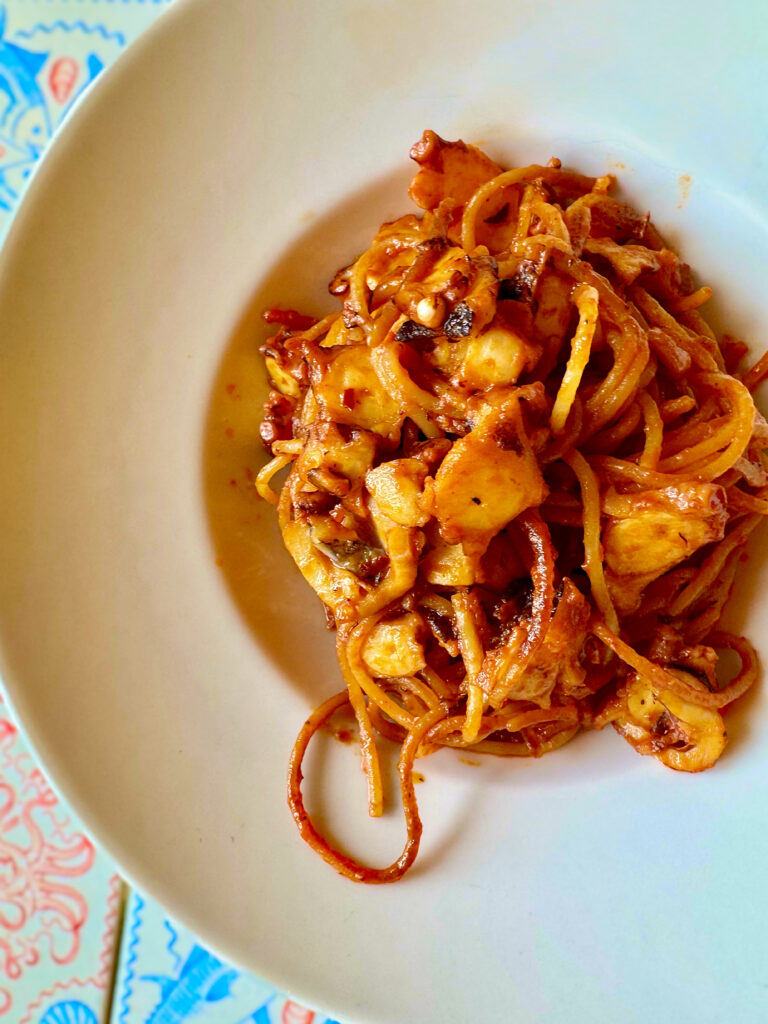
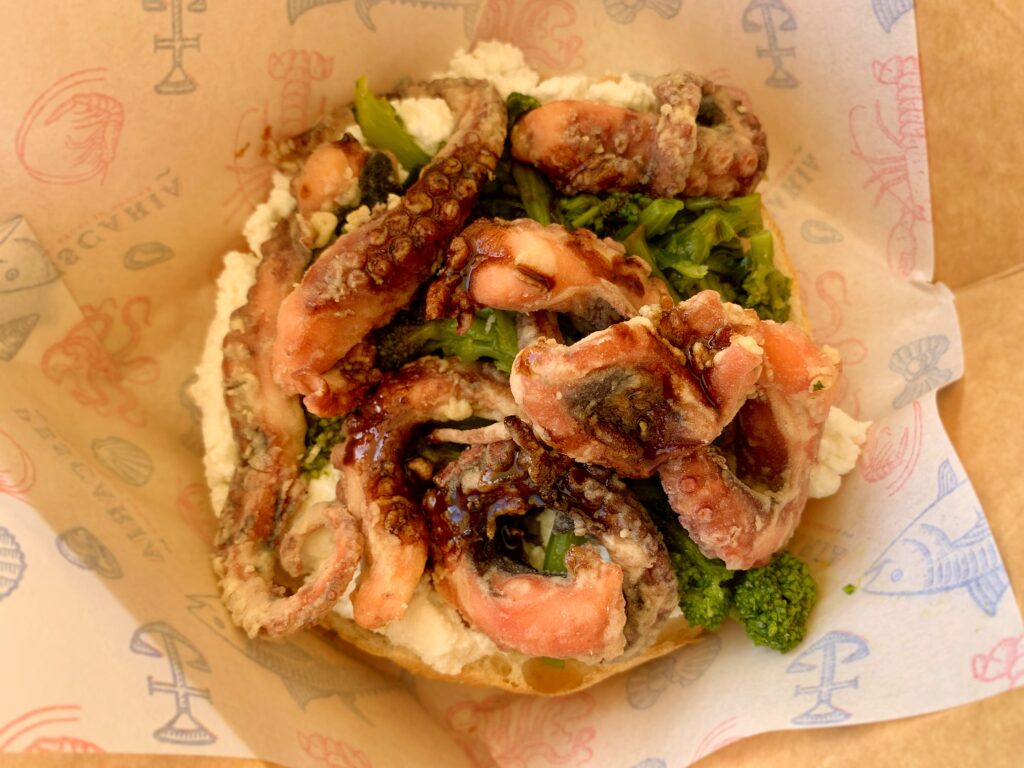
Mint Cucina Fresca
Piazza San Benedetto, 32 | +39 080 4241373 | mintcucinafresca.com |€€–€€€
A tiny, intimate restaurant perfect for a romantic dinner, bringing creativity to seasonal produce. Try the fish burger with caramelised pineapple, sprouts, purple potatoes and Polignano carrot spaghetti. Closed Sunday and Monday nights, and from late October until 21 March.
Ristorante Antiche Mura
Via Roma, 11 | ristoranteantichemura.it | €€€
A consistently praised fine dining choice, serving excellent seafood and local wines. Elegant without being stuffy, this is one of Polignano’s most reliable higher-end options.
Casa Mia Trattoria and Pizzeria
Piazza Garibaldi, 38/40 | +39 080 3325161 | casamiapolignano.com | €€–€€€
A trattoria with a modern touch, complete with wood-fired pizza oven. Cooking is homely and fresh, though the experience can be mixed — especially if you’re tempted to share just one pizza.
Casa Orecchietta
Piazza Caduti di V. Fani, 7 | casaorecchietta.it | €
Polignano’s answer to homestyle Puglian cooking. Handmade orecchiette is the star, served in a simple family-style setting. A good choice if you want to taste traditional cucina casalinga at very fair prices.
Bella ‘Mbriana
Piazza Vittorio Emanuele II, 22 | bellambriananelmondo.com | €–€€
A budget-friendly, laid-back spot serving pizzas, local pasta dishes and seafood. Good portions, friendly service, and a lively atmosphere make it a reliable choice for casual dining without breaking the bank.
Mario Campanella “Il Super Mago del Gelo”
Piazza Garibaldi, 22 | ilsupermagodelgelo.it | €
An institution since 1935, this gelateria has served ice cream to celebrities and locals alike. Photos of famous patrons line the walls. Don’t miss their speciality coffees — an unusual and much-loved house tradition.
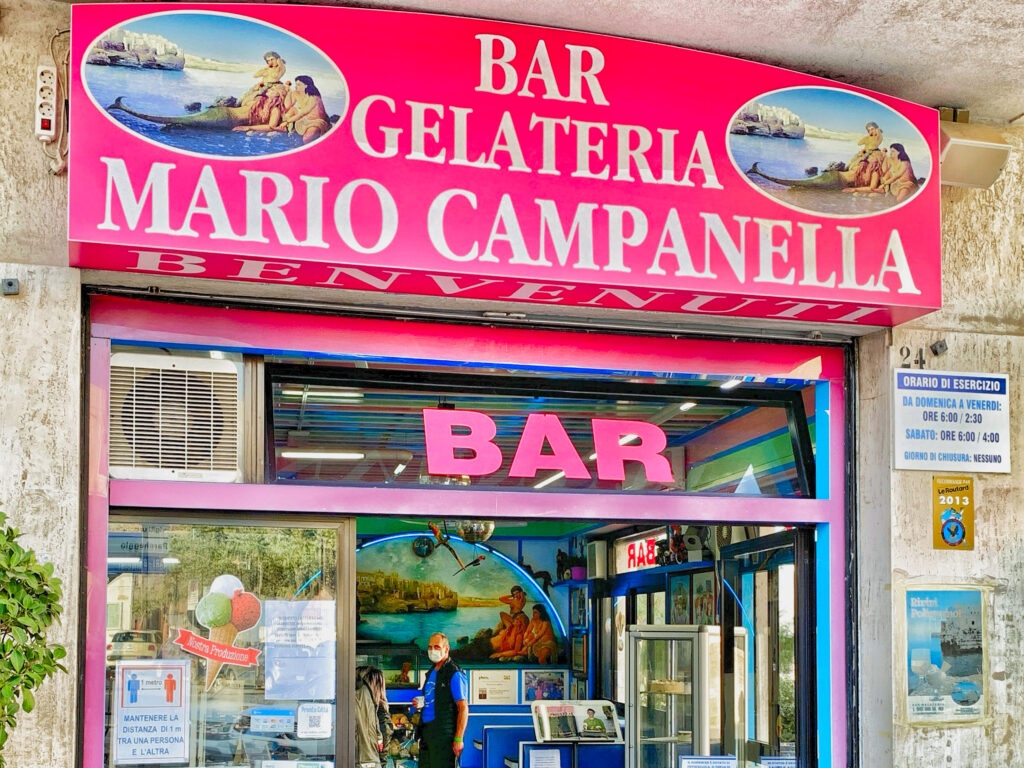
Terrazze Monachile
Via Lama Monachile, 11 | terrazzemonachile.com | €€€–€€€€
Set above Lama Monachile with views as impressive as the setting sun. Italian visitors rave about the service and return often. The food can feel a little polished, but it’s still swiftly devoured. Come for the view, stay for the atmosphere.
Da Tuccino
Contrada Santa Caterina, 69/f (Polignano a Mare seafront) | tuccino.it | €€€–€€€€
Just outside Polignano, Da Tuccino began life as a seafood stall before becoming a legendary raw seafood restaurant. The fish counter is theatrical, the crudo impeccable, and this remains a place Italian families choose for Sunday lunch. At night the terrace opens, changing the mood completely. If it’s on the menu, try the black orecchiette with clams and courgette flowers, or a whole sea bass roasted with lemon thyme potatoes. Our stand-out recommendation for a special eating out experience in Polignano.
Cactus Bar
Area: Polignano | speakeasybari.com | €
A tucked-away basement book and music bar with arched limestone interiors, mismatched mid-century furniture, and shelves of books and art. Known for its natural wines and mojito variations (including a limoncello version), it doubles as a cultural space with live music and DJs across jazz, blues, reggae and crooners. Drinks arrive with olives — and a deck of cards.
La Casa del Mojito
Via Annunziata, 19 | €
A favourite for cocktails in the old town, this tiny bar is best known for its namesake mojitos. A great stop for pre-dinner drinks before heading out to one of Polignano’s many seafood restaurants.
Gelato in Polignano
No visit to Polignano is complete without gelato. Alongside Mario Campanella’s Super Mago del Gelo, which has been scooping since 1935, you’ll find plenty of artisanal gelaterie dotted around the old town. Expect seasonal flavours — from figs and almonds to Polignano carrots — and join the locals in a ritual evening passeggiata with cone in hand.
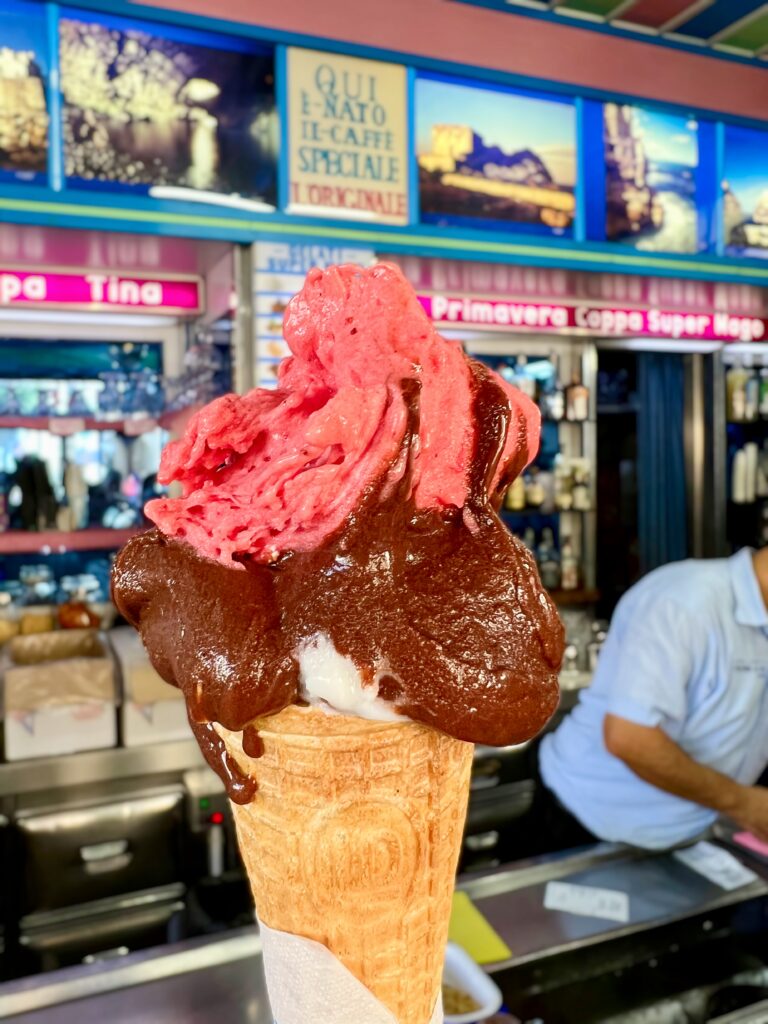
Beaches
Polignano’s coastline is indented with rocky coves and small pebbly beaches, framed by cliffs and caves. The water is exceptionally clear, with a striking turquoise colour. Most beaches are small and fill quickly in summer — go early for a spot.
Polignano’s coastline is indented with rocky coves, pebbly beaches, and sea caves. The water is famously clear and blue — in the blue painted blue.
- Lama Monachile – the postcard beach, framed by cliffs and the Roman bridge. Stunning views, pebbly shore, crowded in summer.
- Cala Paura – a rocky cove with fishing boats pulled up on shore, popular with locals. A great place for an octopus sandwich.
- San Vito – sandy stretch north of town by the Abbey of San Vito. A small harbour with colourful boats and more space than Lama Monachile.
- Cala Portalga – sheltered cove with fishermen’s huts, quieter and atmospheric.
- Porto Cavallo – rocky ledges perfect for sunbathing and diving into deep blue waters.
- Porto Contessa – another small rocky inlet, peaceful compared to the town beaches.
- Grotta dell’Amore – a hidden cave beach accessible only by boat, often included in local grotto tours.
Insider tip: If Lama Monachile looks overwhelmingly busy (as it often does in summer), walk west along the coast and you’ll find some less crammed swimming spots. At Lido Cala Paura, where kiosks serve freshly grilled octopus panini at tables overlooking the sea, you can rent sunbeds, sunshades and pedaloes for a more comfortable beach day.
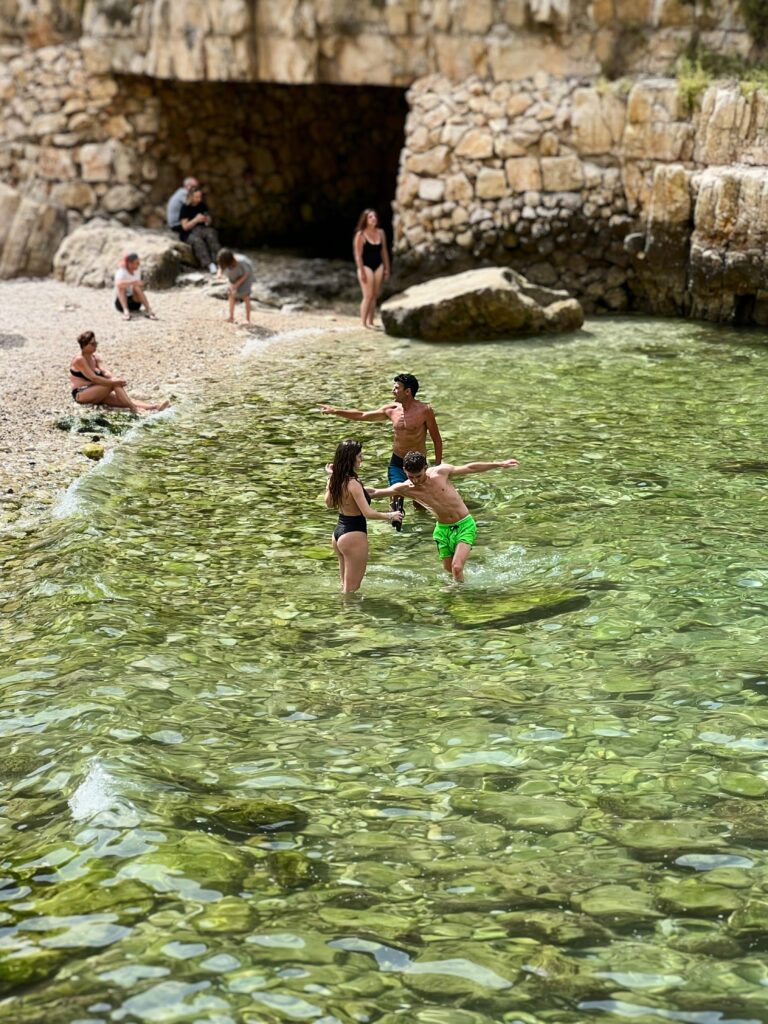
Polignano as a smart base
Polignano’s cliff-top drama and iconic views make it one of Puglia’s most photographed towns, but that popularity comes with a price. Accommodation is more expensive here than in Monopoli or the inland Valle d’Itria towns, and in peak summer the narrow lanes and small beaches feel very crowded. For that reason, many travellers prefer to stay nearby and visit Polignano for a day.
That said, Polignano is extremely well connected and works as a smart base if you want to combine coast, culture, and day trips without moving too often. The Trenitalia station is just a short walk from the town centre, making it easy to reach Bari, Monopoli, Brindisi and even Lecce by train. Even with your own car, we often recommend taking the train for day trips — it saves the hassle of parking in other cities.
For road trips, Polignano sits conveniently on the SS16 coastal highway, so you can be in Alberobello, Ostuni or the Valle d’Itria in under an hour, while the beaches of Capitolo and the Salento coast are also within reach.
For more on planning your trip, see our Best Bases in Puglia Guide and Puglia Itineraries Guide.
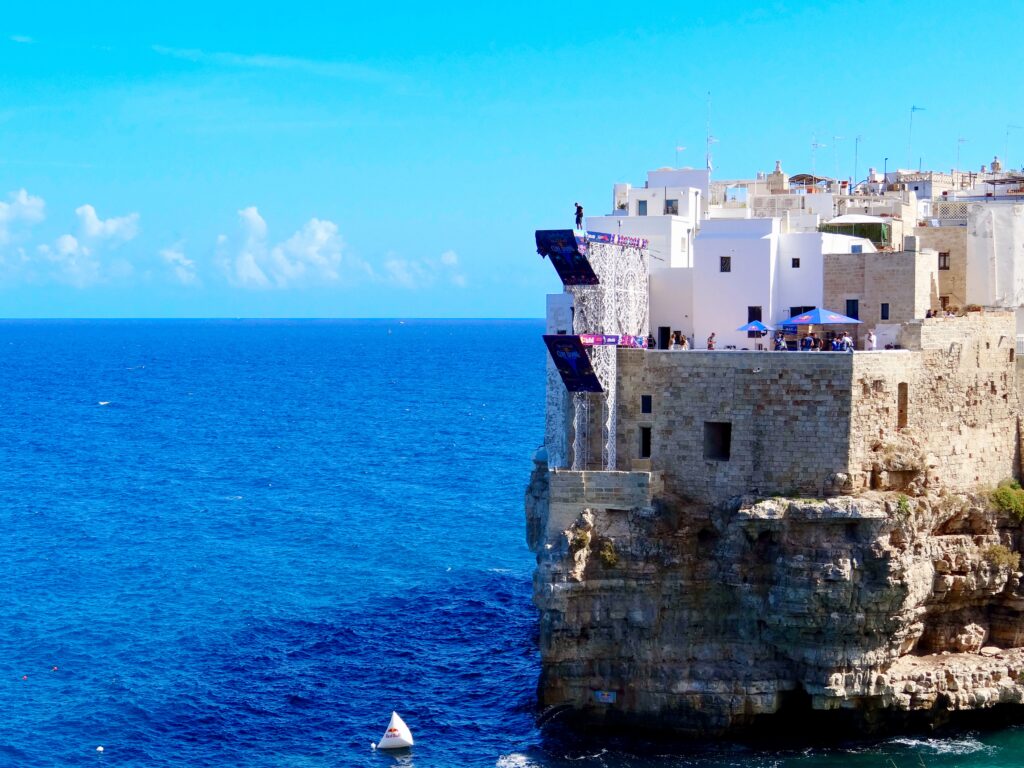
Good to know | practical tips
- Crowds: Polignano is one of Puglia’s most popular destinations. In July and August the centro storico and Lama Monachile are packed. Go early morning or outside peak season for a calmer experience.
- Pebbles not sand: Beaches are rocky or pebbly. Bring swim shoes if you plan to get into the water.
- Parking: Limited in town. Use paid car parks outside the centre and walk in. In summer, avoid driving into the old town area.
- Cliff jumping: Locals and teenagers leap from the cliffs around Lama Monachile. Watch if you like, but resist the temptation — it’s dangerous and has been fatal.
- Footwear: The old town’s lanes are uneven and polished smooth by centuries of use. Comfortable shoes are best.
- Boat tours: The most rewarding way to see Polignano is from the sea — caves, cliffs, and hidden coves are unforgettable. Book ahead in high season.
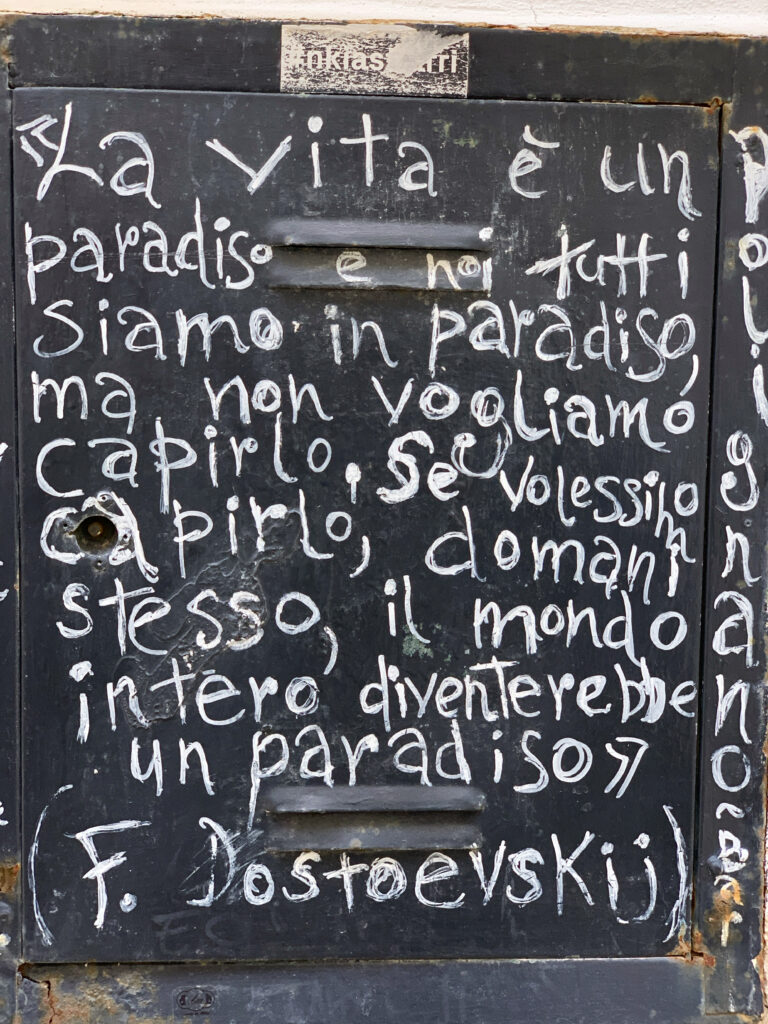
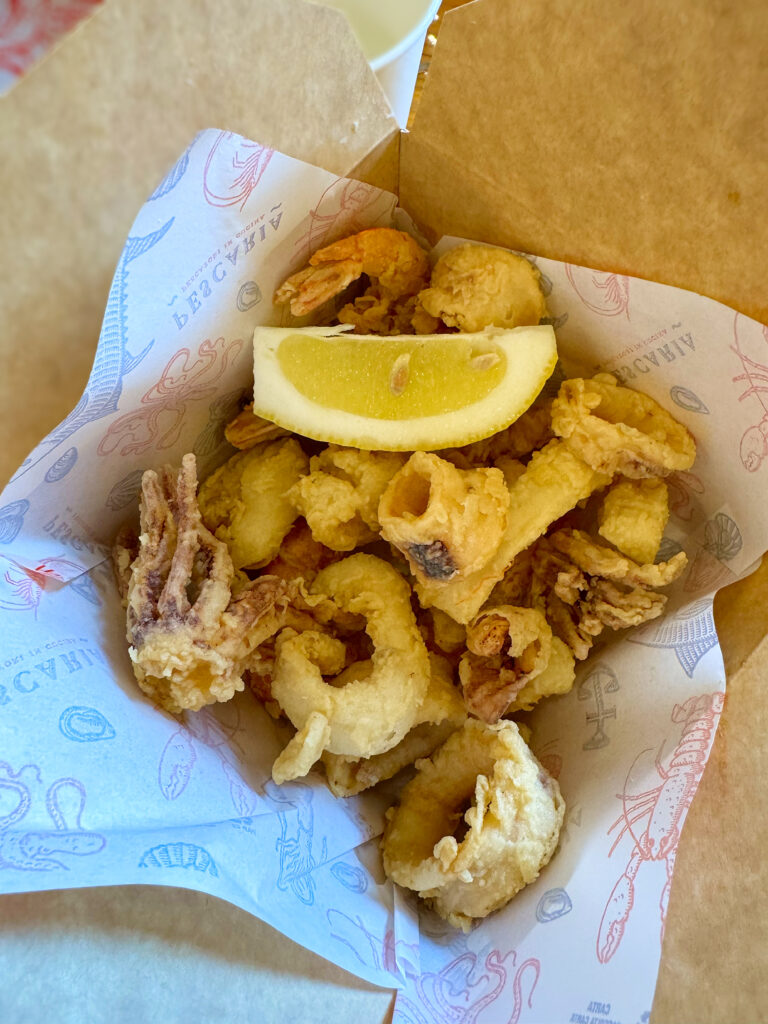

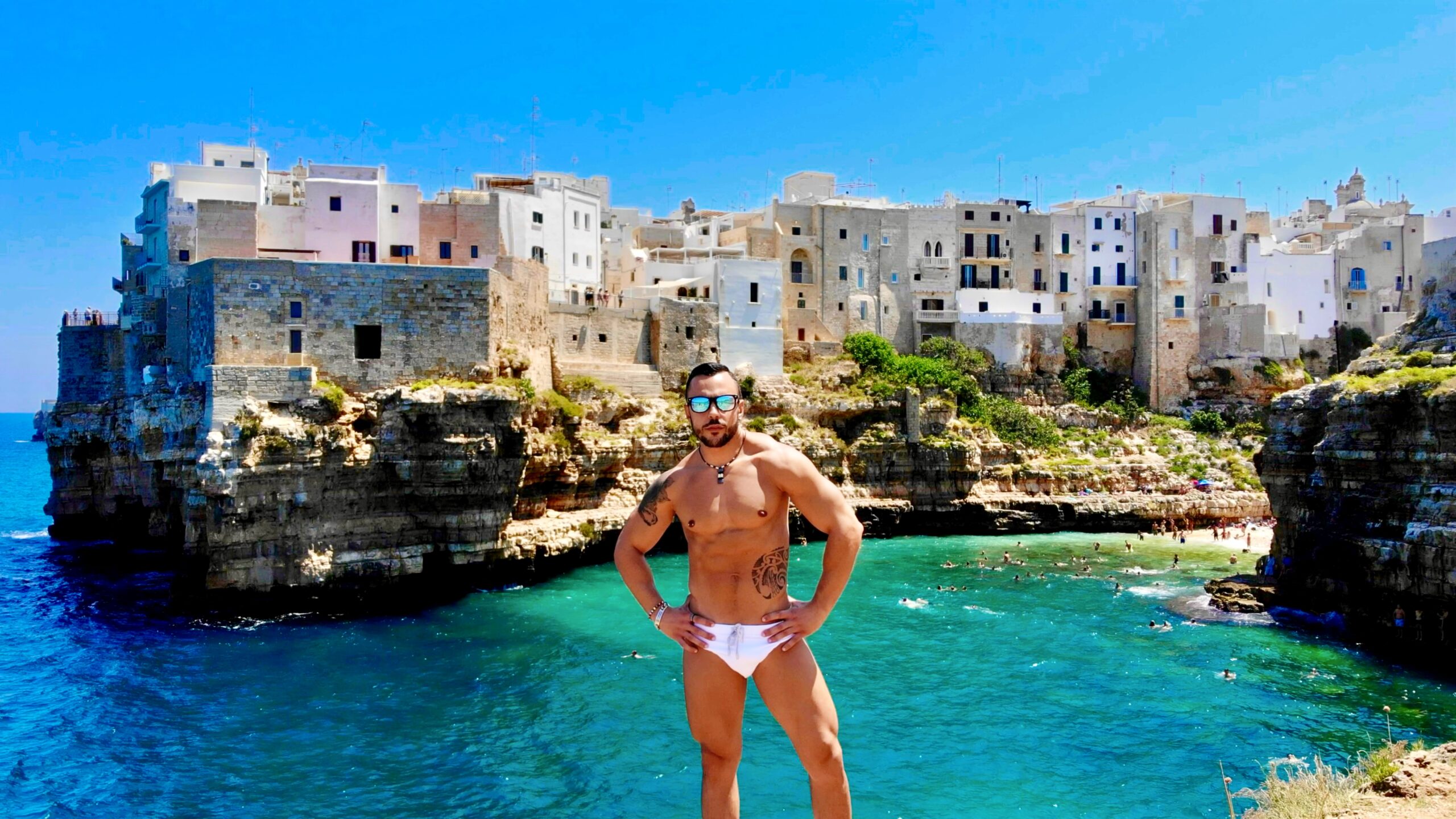
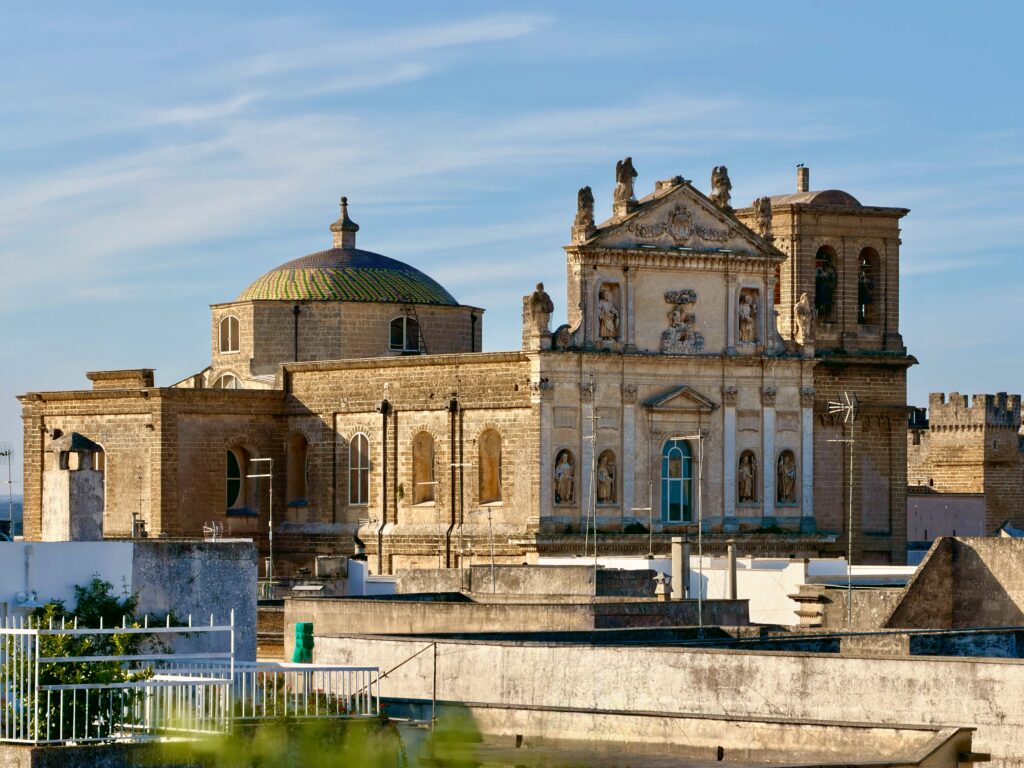
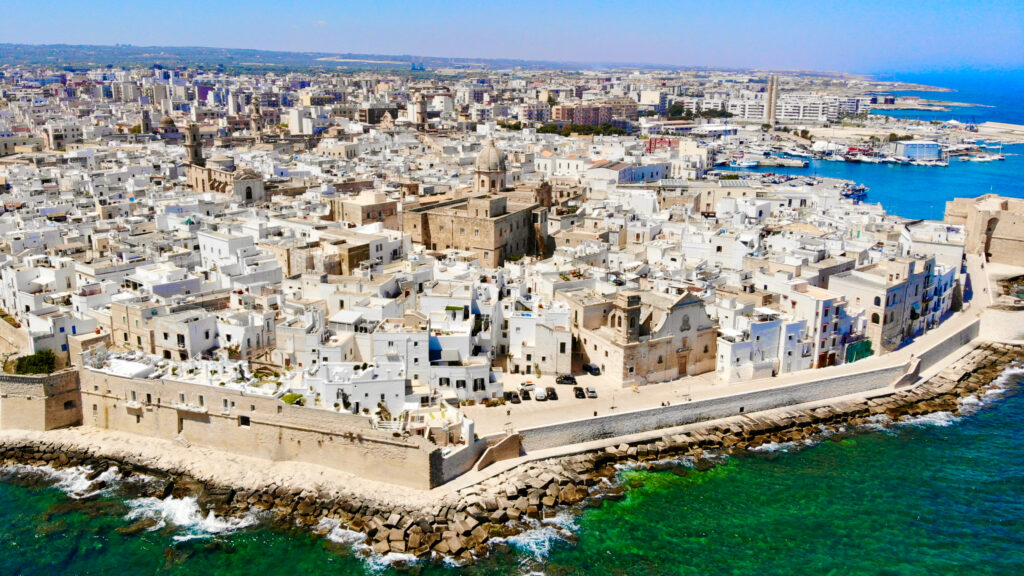
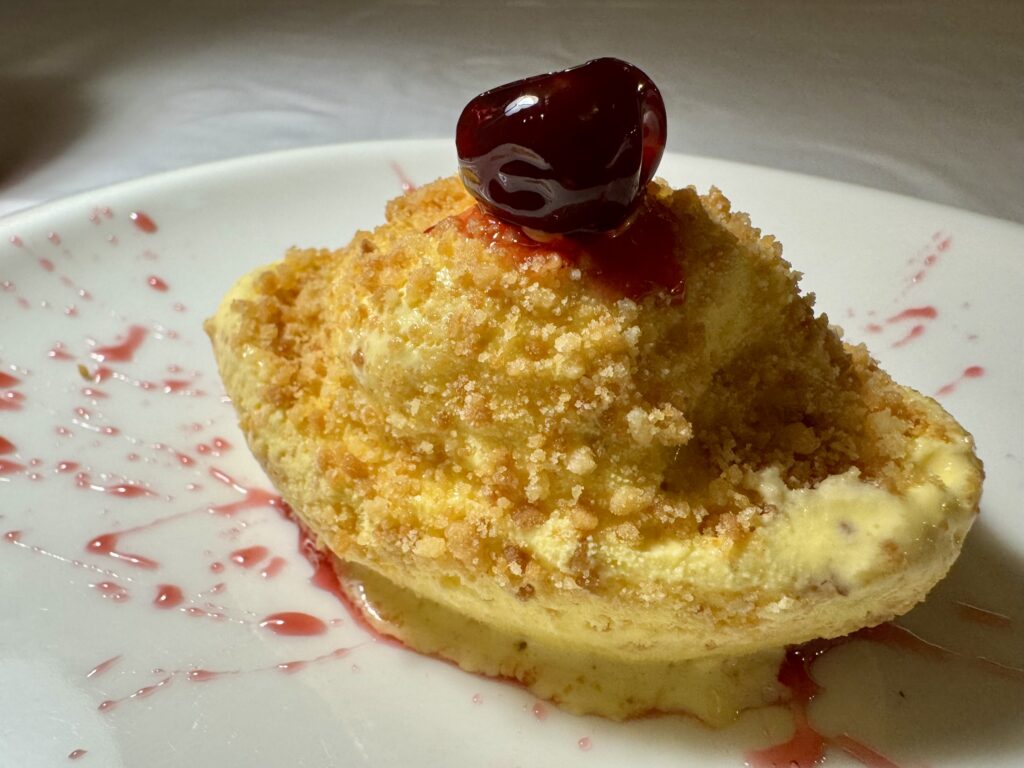
Thank you for sharing your wonderful advice! We have secured our week in Puglia for the end of September into the beginning of October 2026. Can you please help us with dining options for my husband? Sadly he has a later in life allergy to shrimp, lobster, crab and trout. We see so many of the restaurants specialize in seafood. Your help is greatly appreciated. We will be in central Puglia and in the south. We love a mix of local, casual favorites and any upscale not to miss dining experiences. It’s our 30th anniversary trip, Thank you!
Ciao, and congratulations on your 30th anniversary! What a wonderful way to celebrate – late September into early October is one of our favourite times in Puglia. The weather is still warm, the sea inviting, and autumn produce starts to appear on menus.
You won’t struggle at all with the allergy. While seafood is important here, Puglian cooking is just as famous for its meat dishes and vegetable-led cucina povera. Expect orecchiette with cime di rapa, spaghetti all’assassina – an absolute must – bombette (meat rolls stuffed with herbs and cheese), parmigiana di melanzane, burrata, wild chicory and focaccia. Even in restaurants where fish is a focus, you’ll always find non-seafood options.
All our city guides have our favourite recommendations, so take a look at these. Keep in mind that some of Puglia’s best eating is had at family run trattorie and osterie. We also have a separate best (our favourite) restaurants in Puglia guide. We also have a dedicated Eating Out in Bari guide. One of our favourite places to visit for eating out. Here we tend to choose the restaurant depending on the dish we want.
For central Puglia (Ostuni, Ceglie Messapica, Cisternino, Martina Franca, Locorotondo):
Head to the bracerie in Cisternino, where you pick your meat at the counter and have it cooked over the coals – a classic local experience.
In Ceglie Messapica, you’ll find some of the best food in the Valle d’Itria.
Martina Franca is known for its capocollo, so any traditional trattoria there will serve excellent salumi dishes.
For the south (Lecce, Gallipoli, Otranto):
In Lecce, Alle Due Corti is a family-run spot much loved by locals for traditional, hearty Salentino food. Le Zie is another Lecce favourite – simple, homely, and full of character.
In Gallipoli, beyond the seafood there’s a strong tradition of meat and pasta: try Trattoria La Puritate (famous for fish but with excellent land-based dishes too) or Osteria Briganti for a lively, local atmosphere.
In Otranto, L’Altro Baffo is one of the town’s more refined kitchens.
For a special-occasion dinner, some of the masserie restaurants around Ostuni and Fasano offer beautiful settings and menus that focus as much on vegetables, meat and olive oil as on seafood – perfect for an anniversary evening. Our top recommendation – if you can get a table – is Masseria Moroseta. Details in our Ostuni guide. Or try former Michelin starred Osteria Già Sotto Larco in Carovigno – details in our Carovigno guide.
Enjoy your trip – and your anniversary meal. Buon appetito and tanti auguri!
Gianmarco.
Thank you for all this valuable information. We will review all your advice and enjoy many of your suggestions. Thank you again for being the best ambassadors to Puglia.
Kindly,
Kim